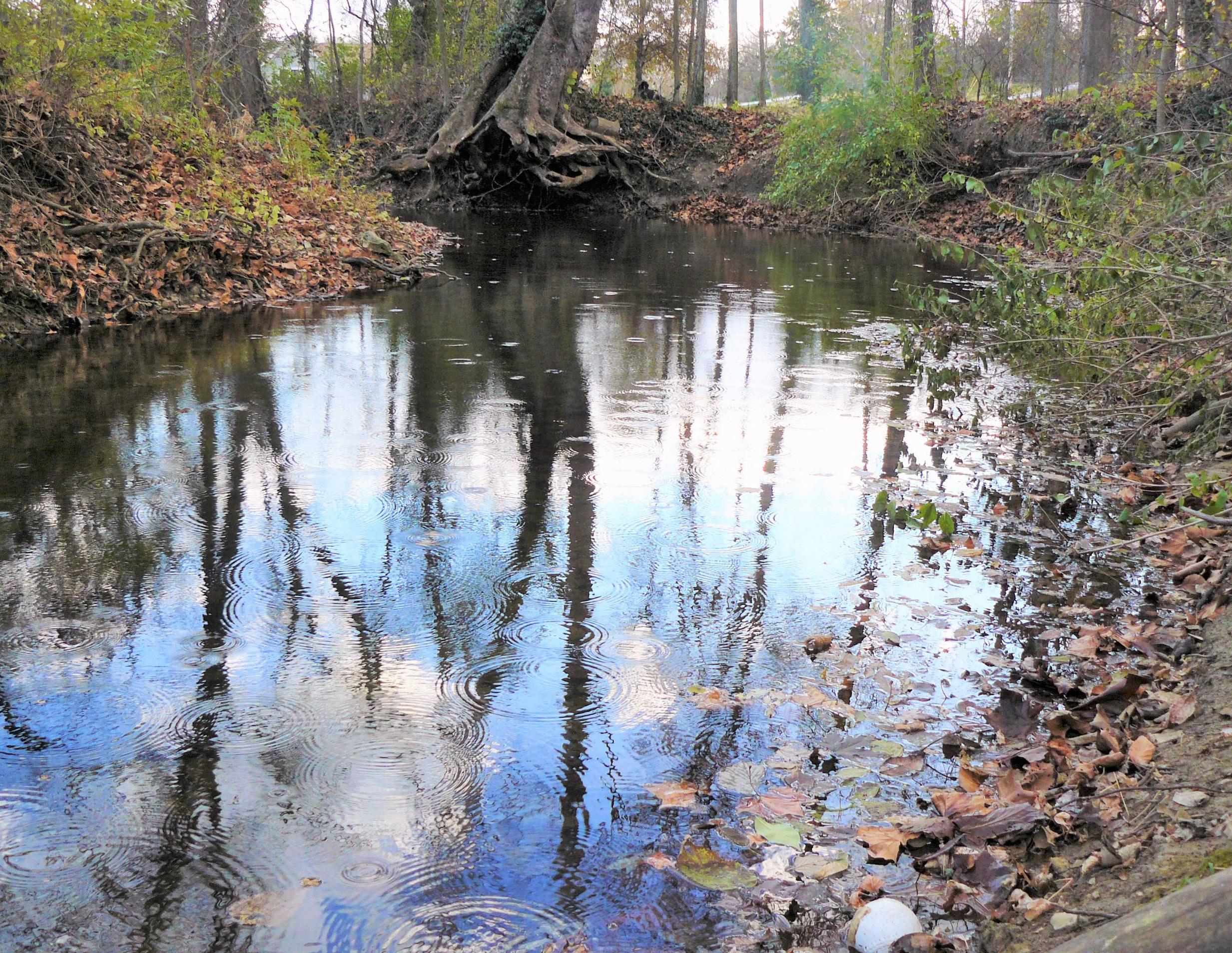
Find out how you can ... Protect water quality & habitat Reduce streambank erosion Preserve property values Decrease flood impacts Stream Care Guide A handbook for landowners in St. Charles County
Keep
The St. Charles County Stream Care Guide is a resource for all county residents to learn more about the ecosystems of the place we call home. This guide provides insight on how to ensure the health and sustainability of not only local natural habitats, but also cities, towns and communities.
Why
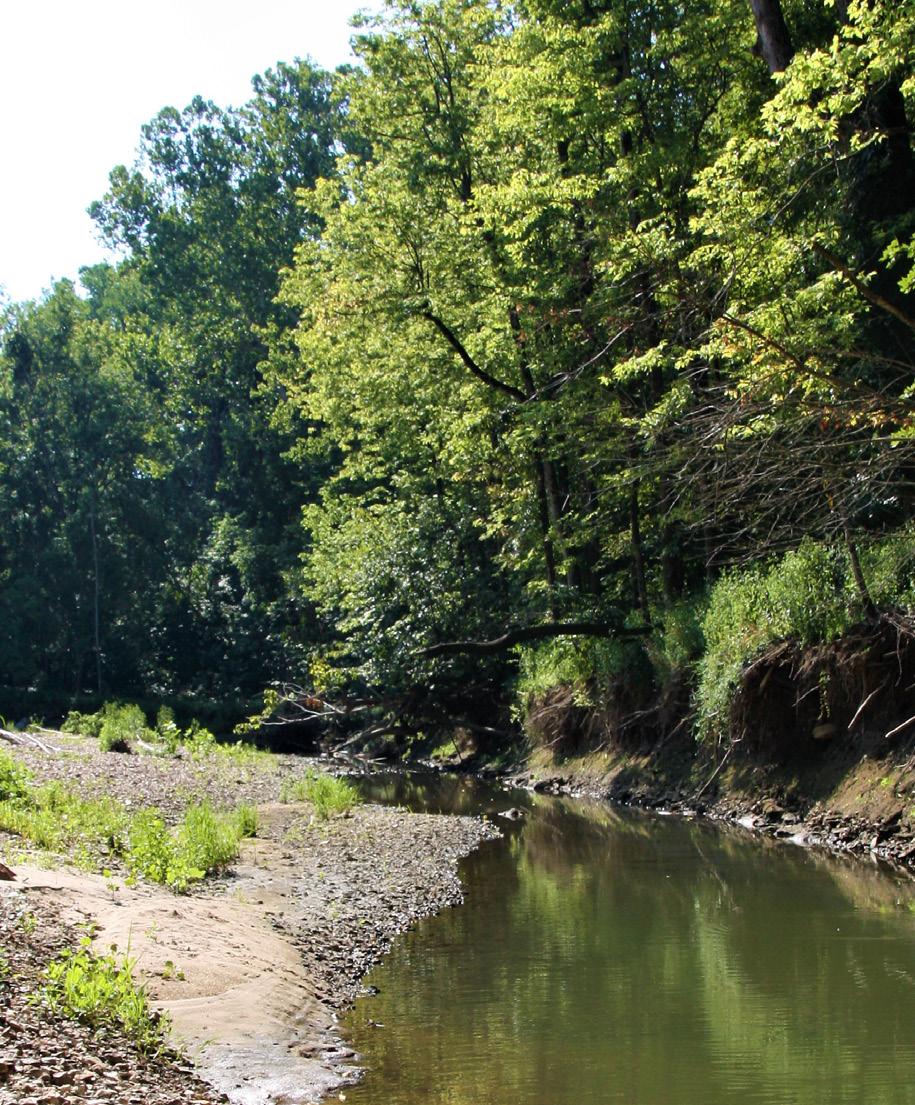
watersheds 101 2 We All Live in a Watershed It All Flows Downstream Rivers Flow to Oceans Local Impacts You Can Help streams 101 4 Streams in St. Charles County Life of an Urban Stream Streams are Dynamic Parts of a Stream Wetlands are a Transition Zone Components of a Healthy Stream Signs of an Ailing Stream Common Stream Threats Water Quality and Beneficial Uses the riparian Zone 8 Protecting Streams Riparian Zone Plants Riparian Zone Benefits Riparian Zone Protection watersheds of st. Charles County 10 Mississippi River Watershed Missouri River Watershed Subwatersheds Creek Close-ups 12 Dardenne Creek Peruque Creek Femme Osage and Howell Island Duckett Creek and Bonhomme Island Cuivre River Lower Missouri/Mississippi Confluence Watershed and Land Use Maps in our Community 20 Low Impact Development Agriculture and Conservation in your BaCkyard 22 Rethink Your Lawn
Stream Buffers
Landscaping, More Naturescaping
Smart about Placing Structures
Maintain
Less
Be
Yard Waste
Banks and Out of Streams
Up After Your Pet
Litter
Off
Pick
Help Tackle
to Keep Pollution Out of Storm Drains
Smart
Septics
System
The Storm Drain Connection Tips
Be
About
Caring for Your Septic
Native Plants: A Smart Choice
Plants
Native Plants Matter Selecting
Weeds Invasive Plant Control Replacing Non-Native Plants Native Plants for Riparian Zones stream staBiliZation 32 Climate Influences Erosion Prevention Stabilization Techniques
You
and
Is There Minor, Moderate or Severe Instability Lessons Learned from a Thousand Streams for more information 38 Plan Approval and Permits Dig Rite — 811
Agencies
Areas
Testing
Programs and Technical Assistance
Concerns
Pharmaceuticals
and
Index References
Guide
What’s Wrong with Non-Natives A Word About
When Should
Call
Expert?
Regulatory
Mitigation
Soil
Cost-Share
Environmental
Native Plant Resources Recycling and Waste Disposal Yard Waste
Engineers, Contractors and Suppliers Resources
Ways to Get Involved
In This
Cover Photo: O'Day
in O'Fallon,
Published by St. Charles County Department of Community Development, 2022
Dardenne Creek, Theresa Strunk
Creek
Theresa Strunk
A Letter from the Rivers
Dear People Beyond Our Banks,
Clean, clear, free-flowing streams are something we all cherish in the Midwest, especially in growing areas such as St. Charles County. Approximately 1,300 miles of streams, including the Missouri and Mississippi rivers, flow through St. Charles County, providing drinking water resources, floodwater pathways, wildlife habitat and numerous recreational and economic opportunities.
You may bike or walk near our banks on the Katy Trail. Maybe you’ve fished or boated our waters and seen that we are teeming with life: fish, turtles, crayfish, clams, otters and more. Our waters pass through diverse, beautiful habitat along the river corridor that is home to deer, turkeys, foxes, turtles, and hundreds of different migratory and song birds, and other animals.
Beyond our banks is where you, the people between the rivers, live. You work, play, go to school, build, buy groceries, wash cars, and do so much more on the land between our waters. Many daily activities affect our water quality, locally and far downstream. As a result, part of the responsibility of protecting streams lies with you, the residents of St. Charles County. As stewards of the two mightiest rivers on the North American continent, please consider our waters.
Everything you do in your watershed has the potential to affect our county’s tourism, flooding, tax dollars, and the beauty of life’s most important natural resource: WATER.

In this guide you’ll find out how you and your neighbors can:
• Prevent or minimize erosion issues.
• Avoid flooding impacts.
• Protect property values.
• Preserve water quality.
• Contribute to the survival of fish and wildlife. Every bit of stream care helps. Jump inside to learn more!
Thank you,
St.
County Stream Care Guide | 1
the Mighty Mississippi and the Big Muddy Missouri Frontier Park, St. Charles, www.nationalshare.org
Charles
Watersheds 101
Watersheds can cross city and county boundaries, and everything that happens in a watershed may ultimately affect the water quality of the stream, river, lake or ocean at the end of the line.
We All Live in a Watershed
A water what? A watershed, or drainage basin, is the area of land that drains into the same stream, lake, river, or ocean. Topography determines where surface water flows, with surrounding ridgelines defining the boundaries that divide watersheds.
Larger watersheds contain many smaller subwatersheds. For instance, each prairie and woodland stream, or tributary, that flows into one of our county’s larger creeks, like Dardenne Creek or Peruque Creek, has its own watershed. The larger streams, in turn, combine to drain into the Missouri and Mississippi River watersheds. Many regionalscale watersheds ultimately drain into the
The bottom line — no matter where you live, you live in a watershed.

When it rains, pollutants on the ground are picked up by stormwater runoff (i.e. rain or snow melt that flows over the ground) and make their way into streams and rivers.
Developed areas in the watershed have more impervious (non-porous) surfaces, like rooftops and pavement, from which stormwater will flow faster and pick up more pollutants compared to stormwater flowing off undeveloped land.

With growth, more impervious surfaces also can lead to a larger volume of runoff dumping into our streams and rivers. This results in a higher probability of erosion, degraded water quality, impacts on fish and wildlife, flooding, and property damage.
Stream restoration, educational outreach, use of best management practices (BMPs), and collaboration across watershed boundaries are tools used to protect watersheds.
It All Flows Downstream
www.catchmentguidelines.org
Stormwater runoff flows over the land, picks up pollutants, and carries them into waterways. The impacts to local streams and rivers, and ultimately to the waters of the Gulf of Mexico, are devastating to the quality of life for millions of people who live in and rely on the Missouri and Mississippi River basins.
Roughly one third of the land in St. Charles County and its surface runoff drains southeast to the Missouri River. The remaining watershed areas drain northeast to the Mississippi River. Both ultimately then travel south to the mouth of the rivers: the Gulf of Mexico.
Missouri River, Charles Gurch
Best Management Practices (BMP) are methods that have been determined to be the most effective and practical means of preventing or reducing non-point source pollution.
2 | St. Charles County Stream Care Guide
The dashed lines along the ridges in this illustration outline all of the land in this watershed that drains to the lake.
Rivers Flow to Oceans
Fertilizers, urban runoff, and sewage are some of the pollutants that cause elevated nutrient levels in water. Excess nutrients in water can cause abundant algae growth and create hypoxic “dead zones” in rivers, coastal areas and oceans around the world. Hypoxia refers to aquatic areas that have been depleted of oxygen.
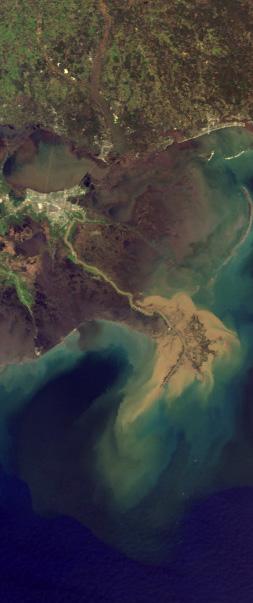
Local Impacts
Stormwater pollution causes degraded drinking water sources, declining ecosystems, loss of aquatic life, degraded property values and loss of industry and economy.
You Can Help
Gulf Hypoxia
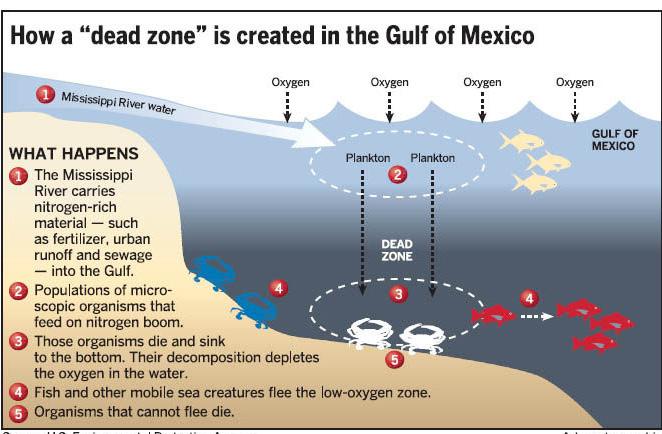
Hypoxia refers to aquatic areas that have been depleted of oxygen. Marine life cannot survive these “hypoxic” (low-oxygen) waters and will leave the area or die. Elevated nutrient levels are the primary cause of excess algae growth and hypoxic ‘dead zones’ in rivers, coastal areas and oceans around the world.
• Allow only rainwater to go down storm drains.
• Sweep up spills and leaks with kitty litter or absorbent. Never hose down.
• Recycle oil, auto fluids, batteries and properly dispose of household hazardous waste. (See Recycling and Waste Disposal on page 39.)
• Control animal waste to prevent it from entering waterways.
• Completely use up paints; small amounts can be air-dried and put in trash with the lid removed.
• Follow label directions; adjust the timing of fertilizer and pesticide applications to reduce runoff.
• Wash cars on the grass or unpaved areas or at a car wash.
• Keep trash out of truck beds and cover garbage containers.
• Dispose carpet-cleaning solution in a sink or toilet.
• Volunteer or share input for your jurisdiction's Stormwater Management Program to improve and protect stream water quality.
Water Pollutants and Causes
Nutrients
Fertilizers
Animal Waste
Leaky Septic Systems
Chemicals
Petroleum & Antifreeze
Paints, Oils & Solvents
Pesticides
Sediment/Mud
Grading, Tree Removal
Tilling, Livestock Trampling
Streambanks
Trash
Plastics
Styrofoam
And More . . .
Liam Gumley, Space Science and Engineering Center, University of Wisconsin/MODIS science team
Sediment plume at the mouth of the Mississippi River, off the coast of Louisiana.
St.
County Stream Care Guide | 3
U.S. Environmental Protection Agency
Charles
Streams 101
Many everyday activities taking place in a watershed can affect stream health: building homes, installing pavement, washing cars, even owning pets.
Streams in St. Charles County
Today, more than 400,000 people call St. Charles County home. Having grown by 70% since 1993, the county is one of the fastest growing in the state. In addition, it is the third largest economic center in the state, hosting a wide variety of retail, agricultural, and industrial businesses, including aerospace and automotive manufacturing, data center headquarters, healthcare leaders, logistics centers, and nationally recognized vineyards and wineries.
Located at the confluence, which is the convergence of the Mississippi River and the Missouri River, the county has the fourth longest river system in the world, and features 46 named creeks traveling over diverse terrain, including urban areas, forests, plains, bluffs and valleys.
St. Charles County and major municipalities within the county have taken steps to help preserve undeveloped land through the establishment of parks, trails, open spaces and connecting greenways.
Life of an Urban Stream
Streams in urban settings go through many changes. Not so long ago, St. Charles County streams were not protected by ordinances as they are now. This meant that construction could take place right up to a stream’s edge, and in some cases, streams were diverted, channelized or even lined with concrete. These types of changes alter a stream’s natural environment and seriously degrade the functions of streams over time.
Among the most damaging consequences of urbanized streams is channel incision, or deepening of the stream channel, and erosion that results in the loss of streamside vegetation. The entire ecology of the stream environment changes when native shrub and tree species are removed. A stream’s ability to control pollutants is lost, and some of the most devastating habitat loss occurs where buildings, paved surfaces and manicured lawns extend to the water’s edge.
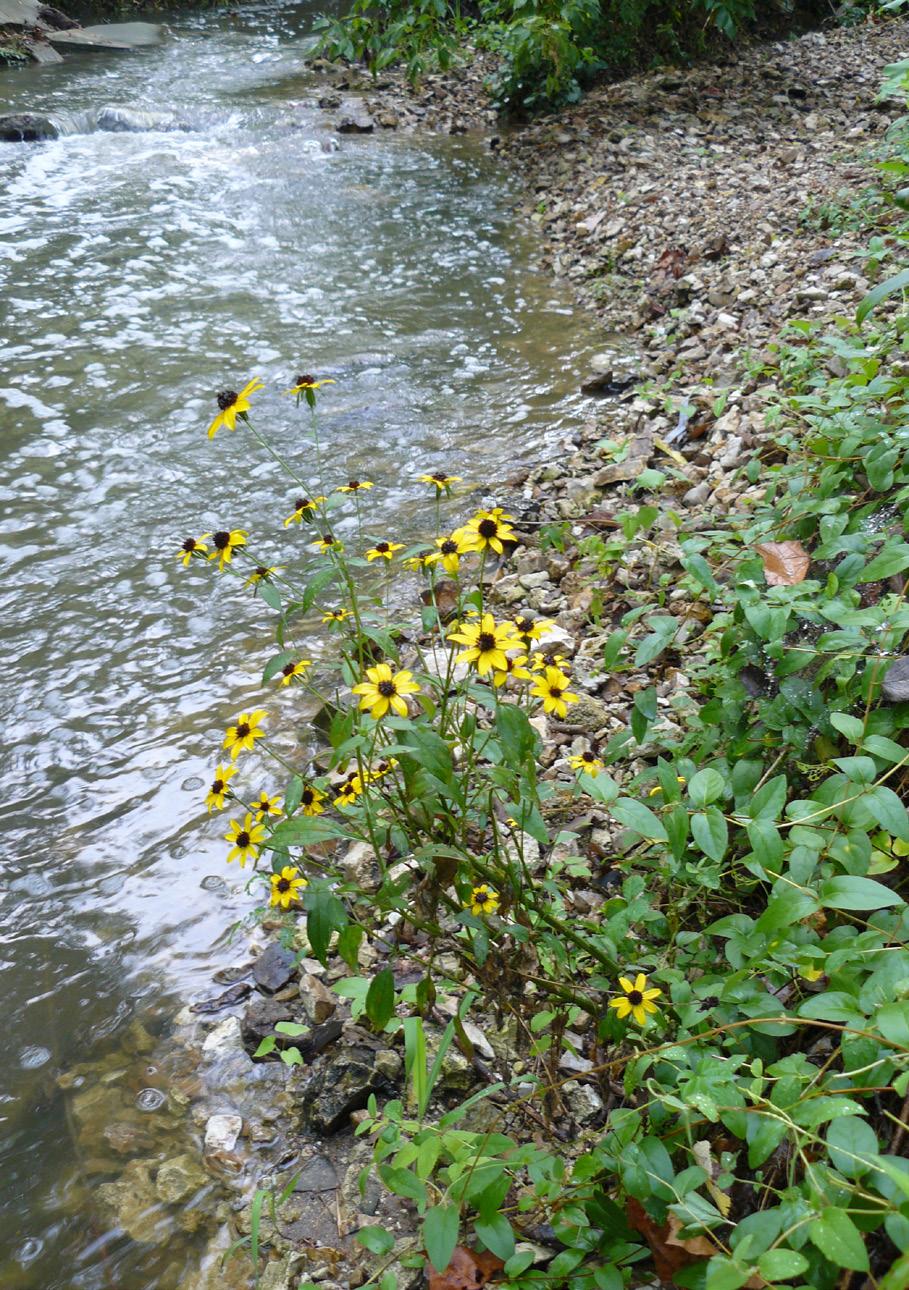
As urbanization spreads, stream waters flow faster, volumes grow larger, and flooding can increase at virtually every constriction, whether natural or man-made. This leads to a higher probability of erosion, degraded water quality, and property damage. These potential impacts are managed through detention basins, stream vegetative buffers, water quality treatment facilities, wetland restoration, and other best management practices on the landscape.
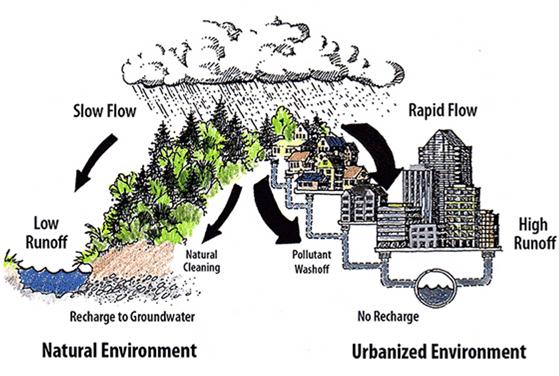 O'Day Creek, Theresa Strunk
O'Day Creek, Theresa Strunk
4 | St. Charles County Stream Care Guide
Salt Lake County Watershed
Streams are Dynamic
A stream is a complex living system where the physical characteristics of the streambed and the valley it is contained within—including its shape, elevation drop (slope), and soil types—interact with dissolved nutrients and organic matter in the water to create an environment rich with life.
Streams naturally change over time. However, changes in climate and activities in the watershed can increase the severity of change that a stream may undergo. Too often, streams are treated as drainage channels, with no other purpose than to move runoff downstream as quickly as possible. Understanding and respecting streams as dynamic ecosystems will go a long way toward protecting water quality and stream health.
Parts of a Stream
Channel—Deeper center section where water collects to flow downstream. On bends, the channel moves to the outside edge of the curve.
Pools, Riffles and Runs Within the channel, pools are deep with slow water. Riffles are shallow with fast, turbulent water tumbling over rocks. Runs are deep with fast water and little or no turbulence.
Streambank—Shoulder-like sides of the stream channel. Healthy systems have plants growing on the streambanks.
Riparian Zone—Transition area between a stream’s edge and the uplands.
Floodplain—Relatively flat land extending outward from the stream where water naturally overflows.
Types of Streams
Perennial—Continuous flow year-round during years of normal rainfall. The stream floor lies below the water table.

Intermittent—Flow seasonally when there is enough water from rainfall, springs, etc. The stream is in contact with the water table.
Bankfull elevation is where the water entirely fills the cross-sectional stream channel without overflowing onto the floodplain.
Riparian zone is the area between the stream’s edge and the upland.
Wetlands are a Transition Zone
Ephemeral— Only flows briefly in response to rainfall or snowmelt. The channel lies above the water table.

Before the 1800s, Missouri touted an impressive 4.8 million acres of wetlands. Through farmland cultivation, levees, channelization and development, that number dwindled to 640,000 acres in the 1980s.
Wetlands are a transition zone between land and aquatic environments that protect the quality of both. They act as sponges to absorb impacts from rising floodwaters, naturally filter pollutants, and provide critical habitat for migratory birds, frogs and turtles.
 Little Femme Osage Creek, Perry Eckhardt
Perennial Ephemeral
Little Femme Osage Creek, Perry Eckhardt
Perennial Ephemeral
St. Charles County Stream Care Guide | 5
Salt Lake County Watershed
Components of a Healthy Stream
• Cool, clear, oxygen-rich water that is free of pollutants and excess algae.
• Gravel and cobble with space between the rocks (not too much silt or sand) for aquatic insects and fish spawning.
• Presence of both slow pools to provide cover and refuge, and riffles (fast water running over shallow rocks) to support aquatic insects, fish spawning and feeding.
• Adequate amounts of water flowing in the stream during summer.
• Fallen logs, branches and other natural debris to provide habitat and cover for aquatic and riparian species.
• Abundant, native riparian (streamside) vegetation to stabilize banks and provide shade, food and shelter for wildlife.
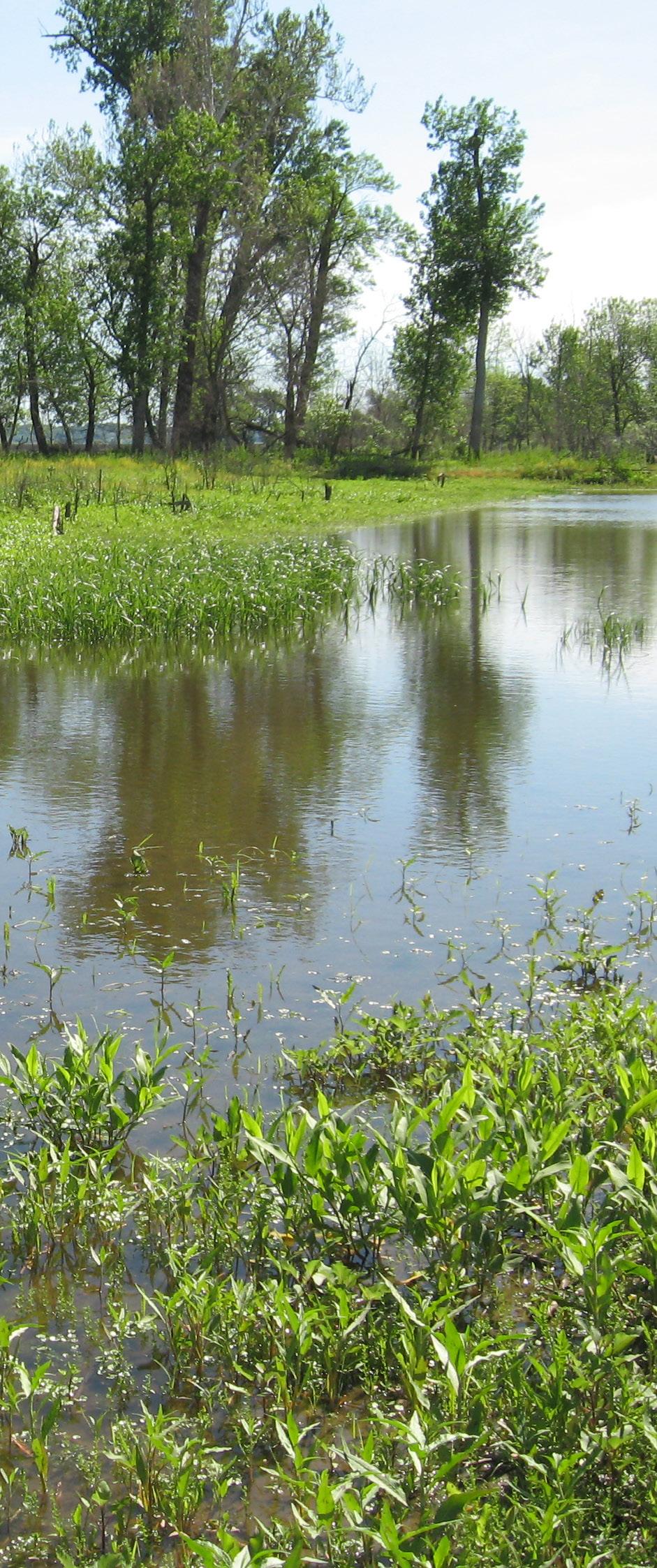
Signs of an Ailing Stream
Water Quality and Flow
• High water temperature.
• Reduced or absent water flow with flash flood conditions during rain.
• Foam more than three inches high that does not break up easily may indicate detergents or nitrogen.
• Shiny or rainbow-colored surface may indicate petroleum or antifreeze.
• Green water could indicate too much algae.
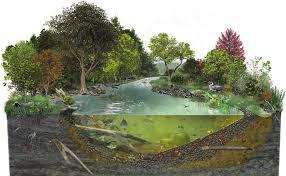
• Orange water may indicate the presence of iron, acidic runoff, or iron-oxidizing bacteria (which is naturally present).
• Brown or muddy water indicates sediments or suspended solids.
• Odor of rotten eggs may indicate sewage waste.
Streambed and Banks
• Deepening (incising) stream channel.
• Straightened stream channel.
• Stream channel lined with concrete.
• Debris such as concrete slabs, old tires, or construction materials dumped on banks.
• Severely exposed soil and tree roots on banks.
• Extremely steep streambanks (greater than 30 degrees).
• Absence of riffles and fast water.
• Litter, grass clippings, leaves, trash and other debris on the top of the streambanks.
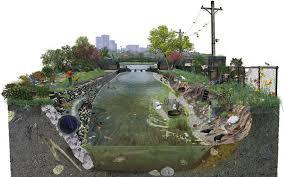
Wetlands along the Missouri River, Missouri Department of Conservation
Impacted Stream USGS Image
6 | St. Charles County Stream Care Guide
Healthy/Unimpacted Stream USGS Image
Common Stream Threats
• Channel alterations reduce or eliminate streamside vegetation and increase flooding and erosion potential.
• Stream diversions reduce instream flows and can completely dewater streams.
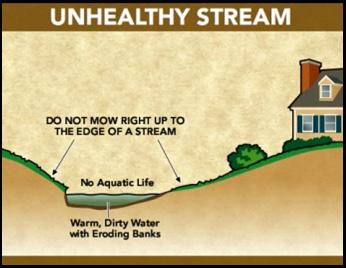

• Loss of native vegetation impacts wildlife food and shelter and reduces shade, endangering fish and aquatic insects. Warm water also contributes to excess algae growth.
• Bare streambanks are prone to erosion.
• Increased storm runoff from impervious surfaces (pavement, rooftops, etc.) can increase flooding and erosion.
• Increased pollutants (oil, gasoline, fertilizer, pet waste, detergents, household toxics, trash, etc.) carried by runoff degrade water quality.
• Excess soil erosion impacts water quality, degrades aquatic habitat, and damages property.


• Excess nutrients (from fertilizers, pet and yard waste and leaky septic systems) cause algae overgrowth, which uses up oxygen in water and impacts aquatic life.
Water Quality & Beneficial Uses
www.phillywatersheds.org
A waterbody is considered impaired by the State of Missouri when it fails to meet applicable water quality standards based on use such as whole-body or secondary-body-contact recreation, irrigation, livestock and watering protection, and warm water habitat.
Streambank erosion, Perry Eckhardt
Streambank erosion on an unnamed tributary.
St.
County Stream Care Guide | 7
Michele Gremminger
Charles
The Riparian Zone
Riparian—Relating to or situated on the banks of a river or stream, or other natural watercourse. Riparian corridor—The transitional area of land that connects the aquatic (wet) ecosystem to drier uplands not reached by flood waters.

Protecting Streams
The riparian zone is the last line of defense to protect our local streams. The ideal riparian corridor width is site specific, but in general a 100-foot wide area on both sides of the steam is recommended. Ideally, the corridor should never be less than 25 feet wide. Landowners with streams or creeks should devote as much yard as possible to the riparian corridor.

Urbanization often results in encroachment of the stream channel and floodplain. The size and depths of the creek are changed, and a dramatic negative impact is often seen in bank stabilization and streamside vegetation in riparian zones.
Riparian Zone Plants
Naturally occurring riparian plants include willows, sycamore, river birch, cottonwood, bald cypress, buttonbush, common elderberry, mist flower, cardinal flower, blue lobelia and various grasses and sedges.
Invasive plant species include autumn olive, bush honeysuckle, callery pear, garlic mustard, Japanese knotweed, Johnson grass, kudzu, multiflora rose, purple loosestrife and winter creeper.
Zone 1: Undisturbed forest From edge of high-water mark on the streambank on both sides to a minimum of 25 feet.
Zone 2: Managed forest Can vary in width, and can withstand some landscaping activities such as limited harvesting of wood products. Trails are located in this zone.
Zone 3: Transition Comprises deep-rooted native grasses, plants and shrubs. This is the buffer to absorb rain runoff and filter excess nutrients from the lawn area.
Friends of Reservoirs
8 | St. Charles County Stream Care Guide
Riparian buffer, www.riverfriends.org
Riparian Zone Benefits
Erosion and Flood Protection
• Extensive riparian root systems stabilize bank soils.
• Vegetation slows in-stream flow and helps to dissipate the energy of rising floodwaters.
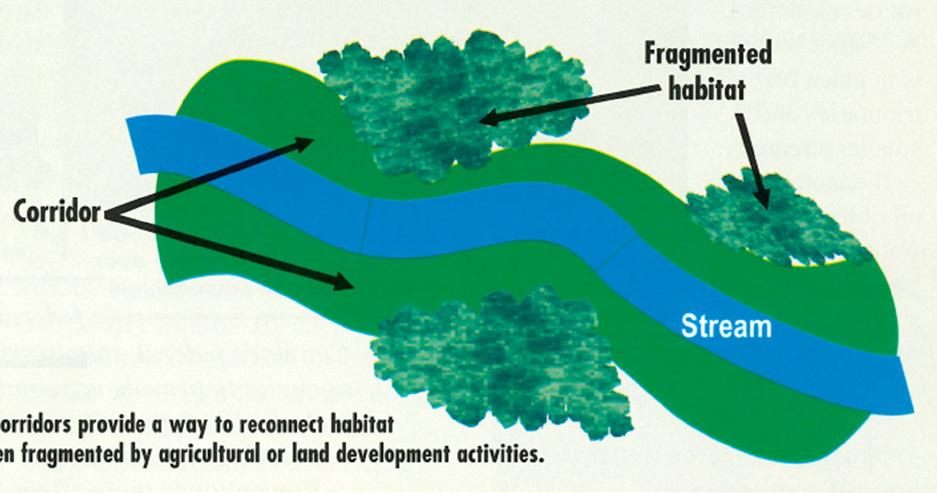
• Floodplains store and absorb floodwaters, dissipating their destructive energy.
Water Quality Protection
• Plants slow runoff as it flows over land, allowing pollutants to settle out before entering the stream.
• Root systems of riparian plants filter pollutants.
• Plants shade and help cool stream waters, which is critical for aquatic species at the base of the food chain.
Food and Shelter
• Multi-story layers of vegetation (trees, shrubs, ground layer) provide habitat and shelter for a variety of species.
• Roots create stable overhanging banks, providing places for fish to hide and rest.
Riparian Zone Protection
Fish & Wildlife Benefits
Riparian vegetation moderates water and air temperatures, provides habitat, and is a food source for aquatic and terrestrial organisms.
Many streams are protected under county and/or municipal ordinances that regulate the protection and management of vegetated riparian buffers. These ordinances include standards for the minimum width and maintenance activities allowed in riparian buffers. See Natural Watercourse Protection Buffers on page 38.
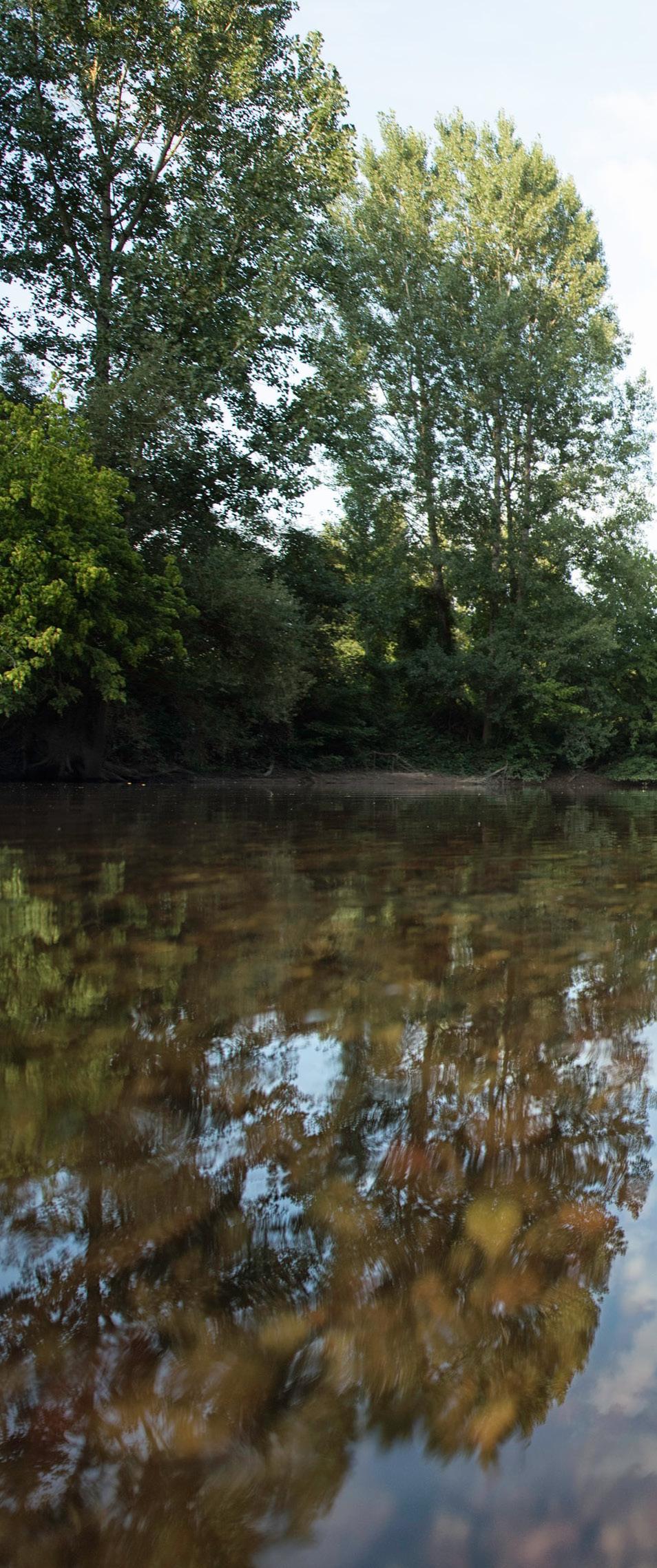
In protected riparian areas, the following activities may only be permitted with prior approval from your city or the County.
• Clearing existing vegetation.
• Disturbing soil by grading, stripping or other methods.
• Altering drainage by ditching, grading, filling, etc.
• Filling or dumping of ANY materials.
• Installing or removing berms or dams.
• Construction of roads, bridges, utility crossings, hard-surface trails, or paths.
Dan Seddon
Protected riparian corridors also provide a way to reconnect habitat areas that have been fragmented by agricultural or land development activities.
St. Charles County Stream Care Guide | 9
Peruque Creek Watershed Alliance
Watersheds of St. Charles County
Mississippi River Watershed
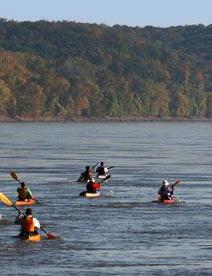
Source: Lake Itasca (Minnesota)
Mouth: Mississippi River, Delta (Gulf of Mexico)
Drainage Area: 1,151,000 mi2 (2,980,000 km2)
Length: 2,340 miles
The Mississippi is the fourth longest and 15th largest river by discharge in the world. It flows through America’s heartland to the Gulf of Mexico, providing drinking water, food, industry and recreation for millions of people. It also hosts a global migratory flyway and is home for over 325 bird species.
The Mississippi River watershed drains the land covering part of two Canadian provinces and 31 states, including all of St. Charles County. More than half the goods and services consumed by U.S. citizens are produced with water that flows through this great watershed.
Subwatersheds include the Red River Basin, Arkansas River Basin, Missouri River Basin, Upper Mississippi River Basin, Ohio River Basin, Tennessee River Basin and Lower Mississippi River Basin.
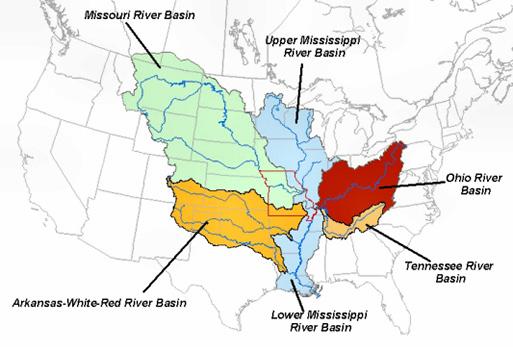
Missouri River Watershed
Source: Mount Elbert, Rocky Mountains (Montana)
Mouth: Mississippi River, St. Louis
Drainage Area: 529,350 mi2 (1,371,000 km2)
Length: 2,540 miles
North America’s longest river, the Missouri River’s headwaters are in western Montana, flowing 2,540 miles before meeting the Mississippi River north of St. Louis. The river drains a sparsely populated, semi-arid watershed of more than half a million square miles, which includes parts of 10 U.S. states and two Canadian provinces. Combined with the lower Mississippi River, it is the fourth longest river system in the world.
Lengths of major rivers
Nile : 4,132 miles
Amazon: 4,000 miles UNITED
Missouri : 2,540 miles
Mississippi : 2,340 miles
Colorado : 1,450 miles
For over 12,000 years, people have depended on the Missouri River and its tributaries as a source of sustenance and transportation. More than 10 major groups of Native Americans populated the watershed, most leading a nomadic lifestyle and dependent on enormous bison herds that once roamed through the Great Plains. The Missouri River was one of the main routes for westward expansion during the 19th century. Pioneers headed west beginning in the 1830s, first by covered wagon, then by the growing numbers of steamboats entering service on the river.
During the 20th century, the Missouri River basin was extensively developed for irrigation, flood control and the generation of hydroelectric power. Fifteen dams impound the main stem of the river, with hundreds more on tributaries. Meanders have been cut and the river channelized or straightened to improve navigation, reducing its length by almost 200 miles (320 km) from pre-development times. Although the lower Missouri valley is now a highly productive agricultural and industrial region, heavy development has taken a toll on wildlife and fish populations, as well as water quality.
WORLD
STATES
Missouri Department of Natural Resources, Water Resources Center St. Charles County is in both the Mississippi River Watershed (blue) and the Missouri River Watershed (green).
10 | St. Charles County Stream Care Guide
Missouri River, Race for the Rivers, Greenway Network
Subwatersheds of St. Charles County
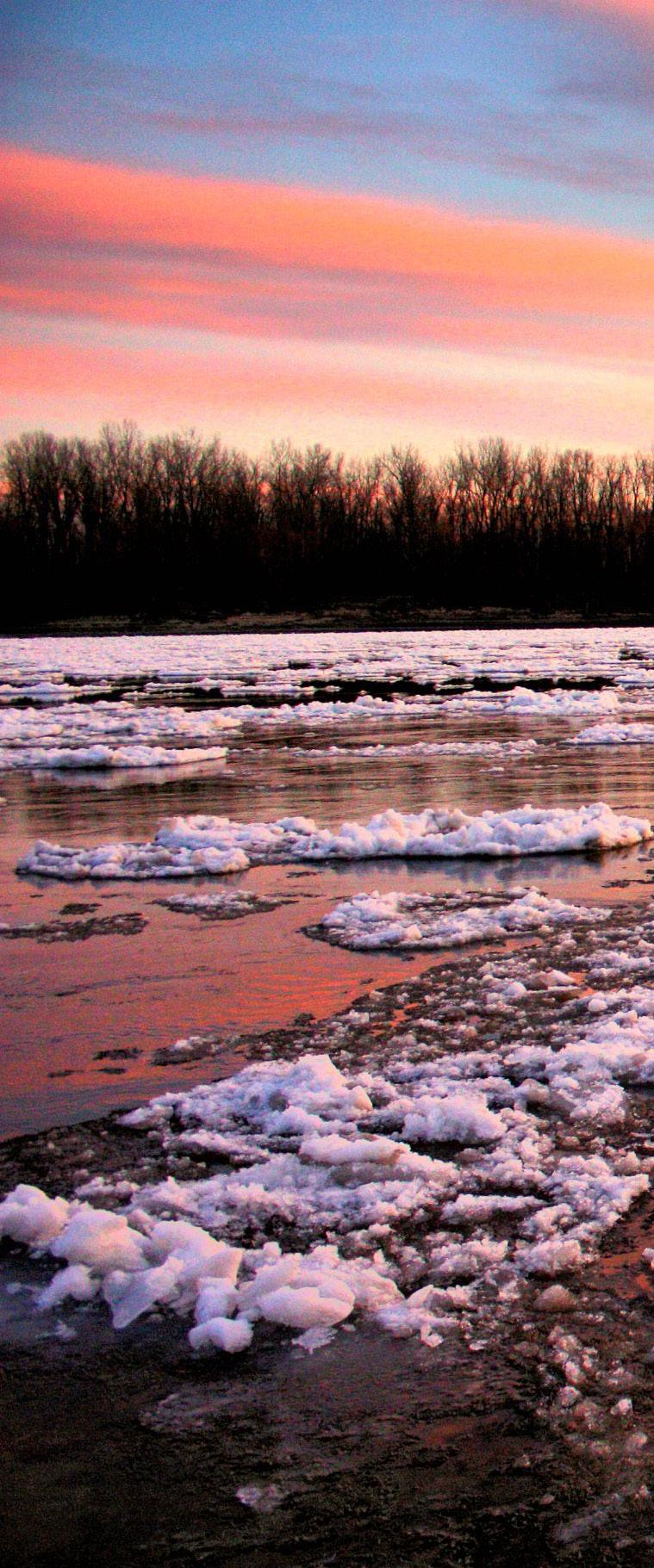
This map depicts eight subwatersheds in St. Charles County. Roughly one-third of the land and its surface waters flow southeast into the Missouri River or filters down to recharge groundwater aquifers. This includes the Duckett Creek, Femme Osage, Charrette, and the Lower Missouri River/ Confluence watersheds.
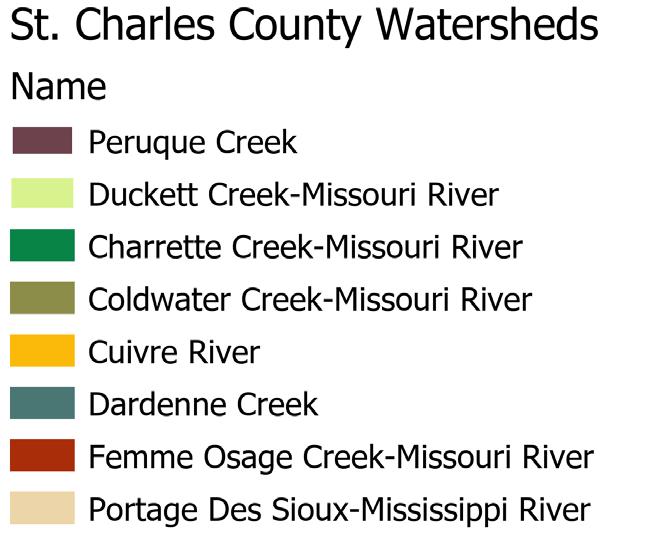
The remaining two-thirds of land in the county, and most surface water, drain northeast to the Mississippi River. This includes the Cuivre River, Peruque, Dardenne Creek, Portage des Sioux and Mississippi River/Confluence watersheds.
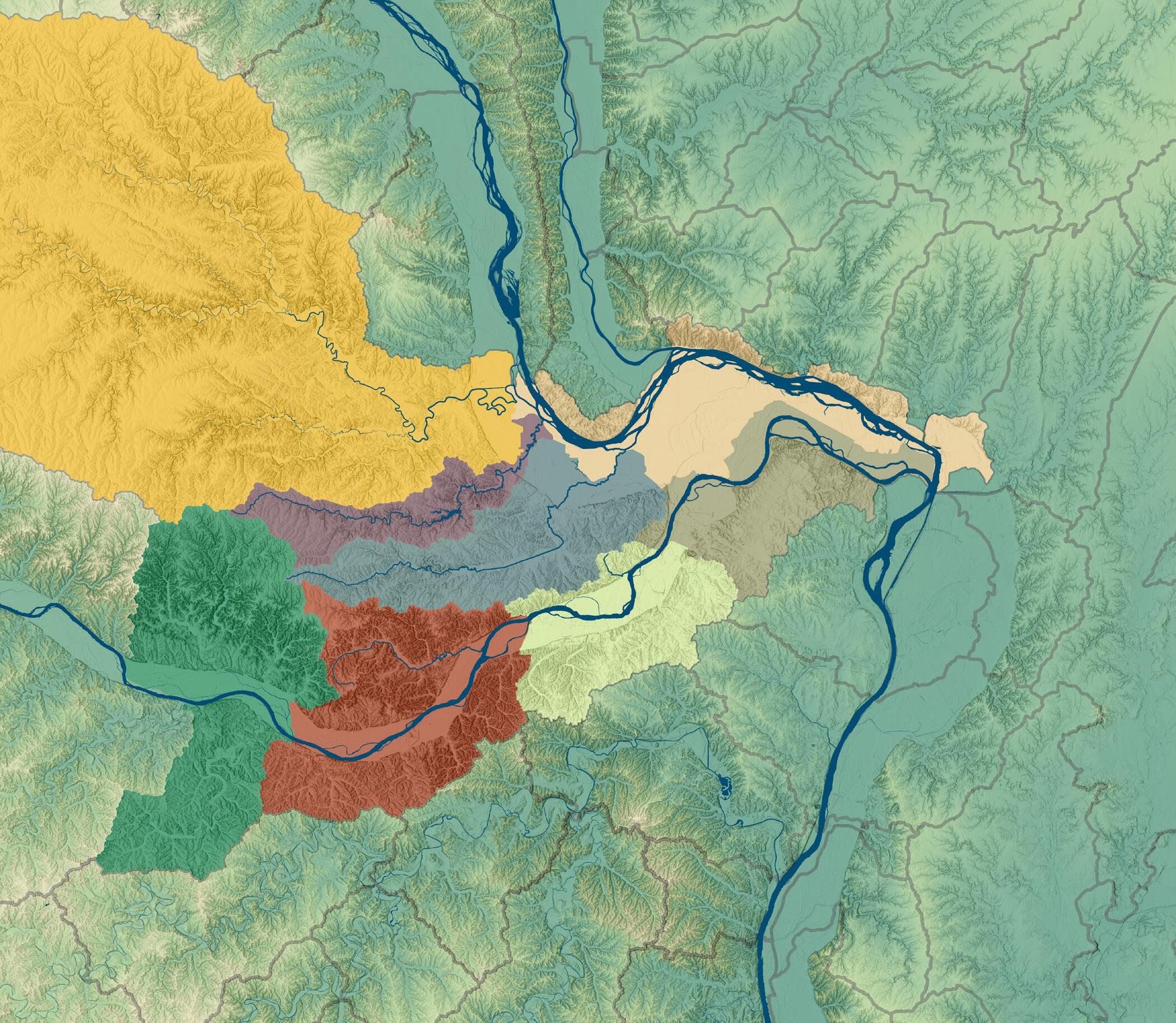 Map Image, Kelly Dunlap
Map Image, Kelly Dunlap
County Stream Care Guide | 11
Missouri River at Klondike Park, Perry Eckhardt St. Charles
Creek Close-ups
Where’s my watershed?
In this section, learn more about a few of our watersheds and tributary streams.

St. Charles County has a total area of 593 square miles, of which 560 square miles is land and 32 square miles is water.
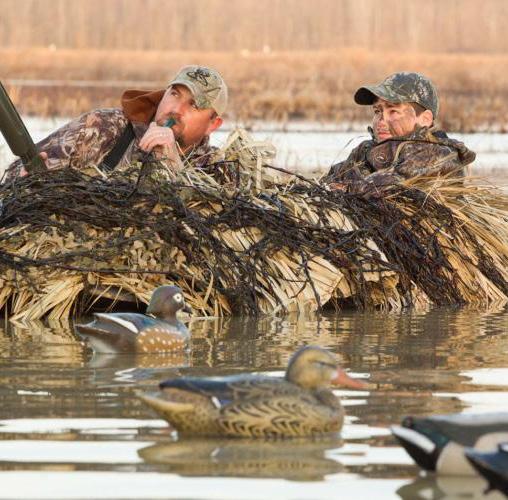
Creek close-up maps on the following pages can help you find your watershed.
Dardenne Creek
If you live in the Dardenne Creek watershed, you may already realize that this stream flows through some of the most densely populated areas in the county. It enters the county west of New Melle and flows through farmland, residential areas, industrial areas, urban centers, and parks and conservation areas. The stream is as diverse as the land it travels, flowing tranquilly through woods and prairies in the August A. Busch Memorial Conservation Area and rushing through channelized sections near urban centers before reaching its mouth at the Mississippi north of St. Charles.
Rapid residential and commercial development puts stress on the stream, causing degradation of water quality and earning it a place on an impaired waters list. Issues include low dissolved oxygen, heavy sedimentation, and low macro-invertebrate counts.

Heavy rains can cause serious flash flooding along portions of Dardenne Creek, threatening property and lives. Stream gages located in O'Fallon and St. Peters provide online, real-time data on water volume and velocity in the creek (https://waterdata.usgs.gov/monitoring-location/05514 860/#parameterCode=00065&period=P7D). This information can be used to provide early warning to landowners and residents when flooding is expected.
Various local groups have been involved in monitoring and improving Dardenne Creek, including Stream Team and Clean Stream efforts that improve and protect important habitat in and along the stream. A 2007 study of the Dardenne Creek watershed by the U.S. Army Corps of Engineers is available at https://www.sccmo.org/1653/Dardenne-Creek-Watershed-Study.
Peruque Creek
Peruque Creek enters St. Charles County just southwest of Foristell and flows across the county through a mix of agricultural land and expanding urban and residential developments. In the late 1960s, a dam was constructed on Peruque Creek to form Lake Saint Louis. Below the dam, the stream passes under Interstate 70 and Route 79 before joining the Mississippi River. Portions of this watershed experienced rapid residential and commercial development, resulting in stream water quality and soil erosion issues that put Peruque Creek on an impaired waters list. To reverse this trend the Peruque Creek Watershed Study and Management Plan was proposed to restore and protect water quality, while sustaining economic development in the watershed. Today, the Peruque Creek is home to 39 species of fish, including green and longear sunfish, orange-throated darters, bluegill, bass and stonerollers. It also provides habitat for egrets, foxes, minks, bluebirds, rabbits, owls, beavers and great blue herons.
Femme Osage Creek and Howell Island
The headwaters of Femme Osage Creek arise northwest of Augusta, near St. Charles County’s highest point of elevation at 903 feet. The stream flows through steeply wooded hills and passes the Daniel Boone Home north of Schluersburg, before flowing toward the Missouri River in the beautiful Weldon Spring Conservation Area.
The hills of the Femme Osage watershed are known for their beautiful vineyards and historic wineries. Despite a spike of residential developments in recent years, this area has managed to remain one of the most natural environments in the County. The Weldon Spring Conservation Area and long wild stretches of the Katy Trail attract hikers, bikers and bird watchers to this rich landscape; while the thick woods, flowing streams and mighty river provide ample opportunities for hunting and fishing.
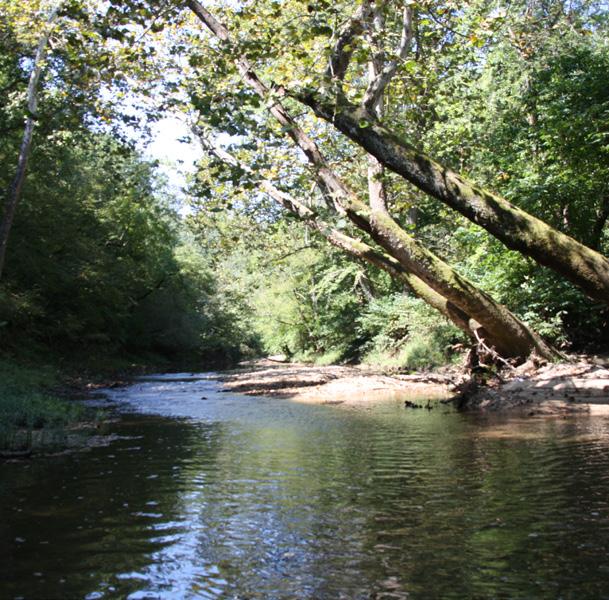 The marshes of the islands and rivers attract duck hunters.
Peruque Creek near Quail Ridge Park.
A view of Dardenne Creek.
Peruque Creek, Perry Eckhardt
Theresa Strunk
Perry Eckhardt
The marshes of the islands and rivers attract duck hunters.
Peruque Creek near Quail Ridge Park.
A view of Dardenne Creek.
Peruque Creek, Perry Eckhardt
Theresa Strunk
Perry Eckhardt
12 | St. Charles County Stream Care Guide
Missouri Department of Conservation
Duckett Creek and Bonhomme Island
The largest part of this watershed lies outside of the county in Maryland Heights and Chesterfield. While only 20 square miles are in the county, this stream drains the largest contiguous urbanized area of unincorporated St. Charles County, discharging into the Missouri River. It includes parts of St. Charles, St. Peters and Weldon Spring.
A large portion of this watershed developed into urban and residential areas prior to stormwater management regulations and the protection of natural watercourses. Beginning in 1977, the Duckett Creek Sanitary District began implementing projects to eliminate sewage lagoons, small package treatment plants and septic tanks. The sanitary district and St. Charles County government worked with residents to identify failing septic systems and provide sanitary sewer service connections.
Today, this watershed experiences typical urban erosion issues. The stream is deeply incised and widened, with little natural floodplain. Much of this is due to lack of stream buffer and setback regulations when the homes were built. The stream flows under Jungs Station Road and the Katy Trail, discharging to the Missouri River about 4.7 miles from downtown St. Charles.
Cuivre River
French settlers named it Riviere au Cuivre (Copper), having been falsely led to believe there was copper near its banks. In other historical documents, Cuivre River was called the Buffalo River (au Boeuf) because of the vast number of bison that once roamed the watershed.
A good portion of Cuivre River’s length serves as the border between Lincoln and St. Charles counties. A major tributary (Big Creek) joins the Cuivre before it discharges into the Mississippi River at Cuivre Island Conservation Area. Approximately one-fourth of the watershed is wooded, with the rest being cultivated, pastured or otherwise developed. The portion of the watershed within St. Charles County has both rural residential and low density residential areas, and large sections between Highways 61 and 79 consist of both industrial and commercial zonings. The northeastern section is mainly agricultural land. Water quality problems are related to soil erosion and animal waste.
Lower Missouri/Mississippi River
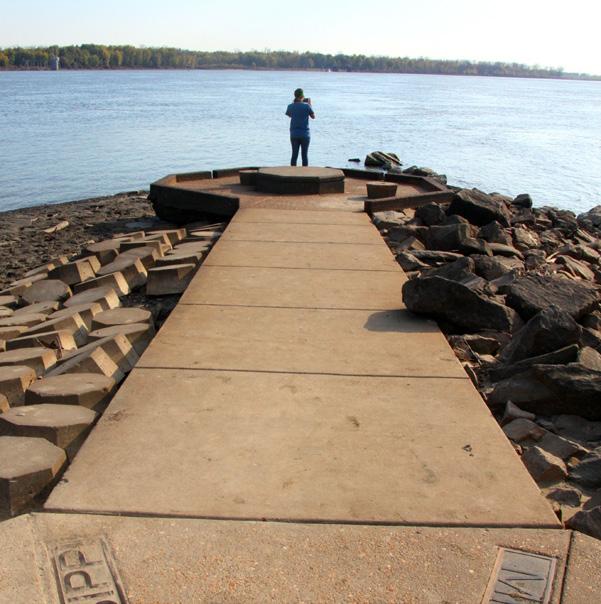
No matter where you are in the county, water that runs off of the land eventually flows past the rocky point jutting into the confluence within the Edward and Pat Jones-Confluence Point State Park. It then flows south toward the Gulf of Mexico.

Two hundred years ago, the land between the rivers was mainly prairie and marsh. The Missouri Department of Natural Resources is currently working to restore a natural floodplain reminiscent of what Lewis and Clark might have seen during their journey up the Missouri River.

The Mississippi River flyway is used by 60 percent of all North American bird species, including 40 percent of all waterfowl. Common birds seen in the area include great blue herons, bald eagles, geese, gulls, pelicans and others.
The Great Flood of 1993 was the greatest flood ever recorded on the upper Mississippi, remaining above flood stage for 144 days (see image at right). The 2019 flooding was similar after the wettest period on record for the U.S., which recorded a top-five crest at every site on the Mississippi River. Nearly 14 million people were affected.
The Great Flood of 1993
Data: Landsat Science Team
These images show the confluence of the Mississippi, Illinois and Missouri Rivers just upstream of St. Louis. The upper image shows the rivers in normal summer conditions (August 1991), while the lower image shows the rivers at the end of the great flood of 1993 (August 1993).
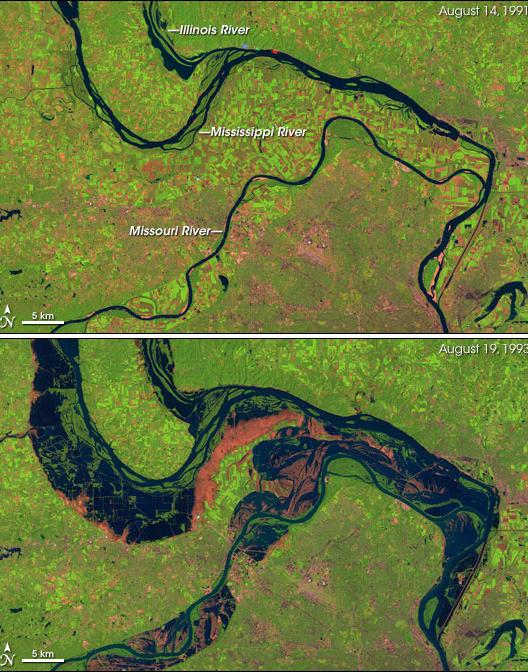 The Missouri/Mississippi Confluence is one of the area’s best places for bird watching.
Kayakers enjoy the Cuivre River.
A rain garden helps with runoff in a neighborhood above Duckett Creek.
Theresa Strunk
Theresa Strunk Missouri Department of Natural Resources
The Missouri/Mississippi Confluence is one of the area’s best places for bird watching.
Kayakers enjoy the Cuivre River.
A rain garden helps with runoff in a neighborhood above Duckett Creek.
Theresa Strunk
Theresa Strunk Missouri Department of Natural Resources
St.
County Stream Care Guide | 13
Jesse Allen
Charles
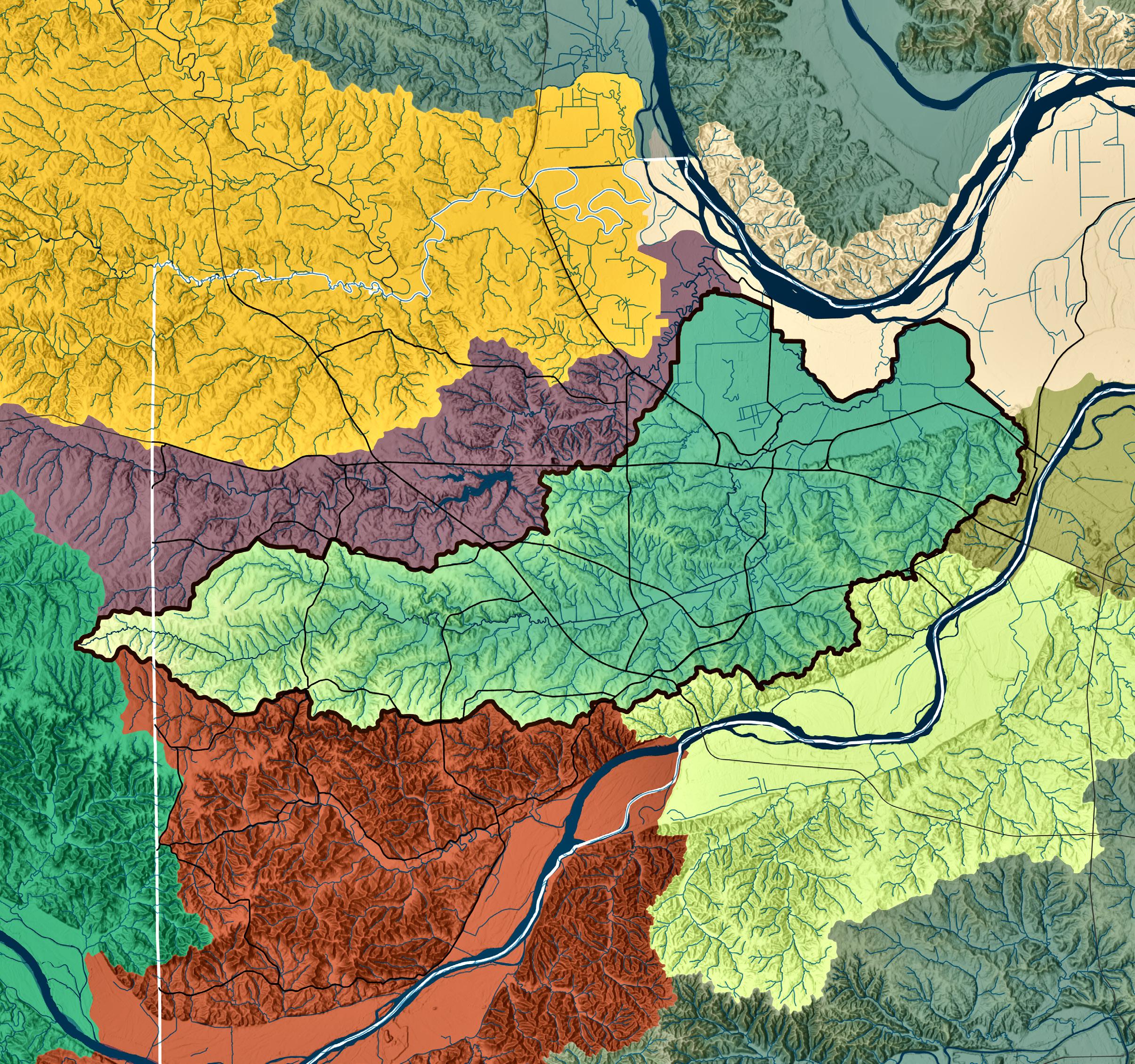






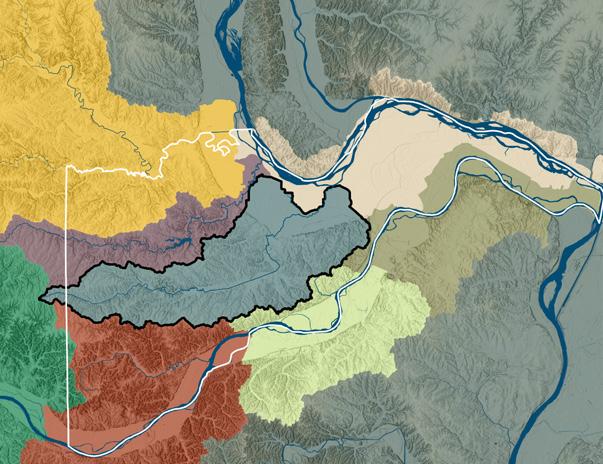




































































• Drainage Area: 165 sq. mi. • Length: 40 mi. • Drains runoff from 26% of the county • Headwaters: Warren County • Mouth: Mississippi River • Creek Elevation Change: 440 ft. (860 to 420 ft.) DardenneCreek 70 70 70 64 64 64 364 79 N 94 370 94 DD P D Z F T K Map Image, Kelly Dunlap Chesterfield Augusta 2 3 4 6 5 7 8 11 9 10 2 Broemmelsiek Park 7 St. Peters City Centre Park 6 Knaust Park 1 The Park at New Melle Lakes 9 Laurel Park 10 Wapelhorst Park 4 O’Fallon Sports Park 5 Ft. Zumwalt Park 3 August A. Busch Conservation Area 8 370 Lakeside Park Parks and Conservation Areas 1 Watershed Land Cover Statisics only represent watershed area within St. Charles County. Land Cover Data: NLCD 2016 High Impervious: Urban Medium Impervious: Agriculture Grass & Wetlands Low Impervious: 23% 53% 24% Forest Shrub, streets, turf grass, etc.) (buildings, parking lots, 12 Riverside Landing 13 Veterans Tribute Park 11 McNair Park 12 13 14 College Meadows Park 14 15 15 Kinetic Park 14 | St. Charles County Stream Care Guide
Dardenne Creek Watershed
Peruque Creek Watershed
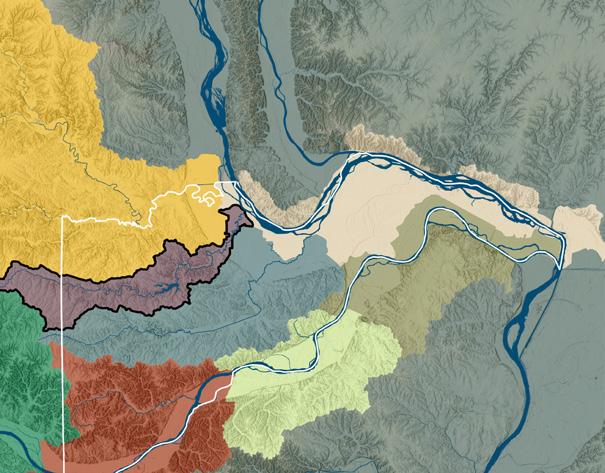
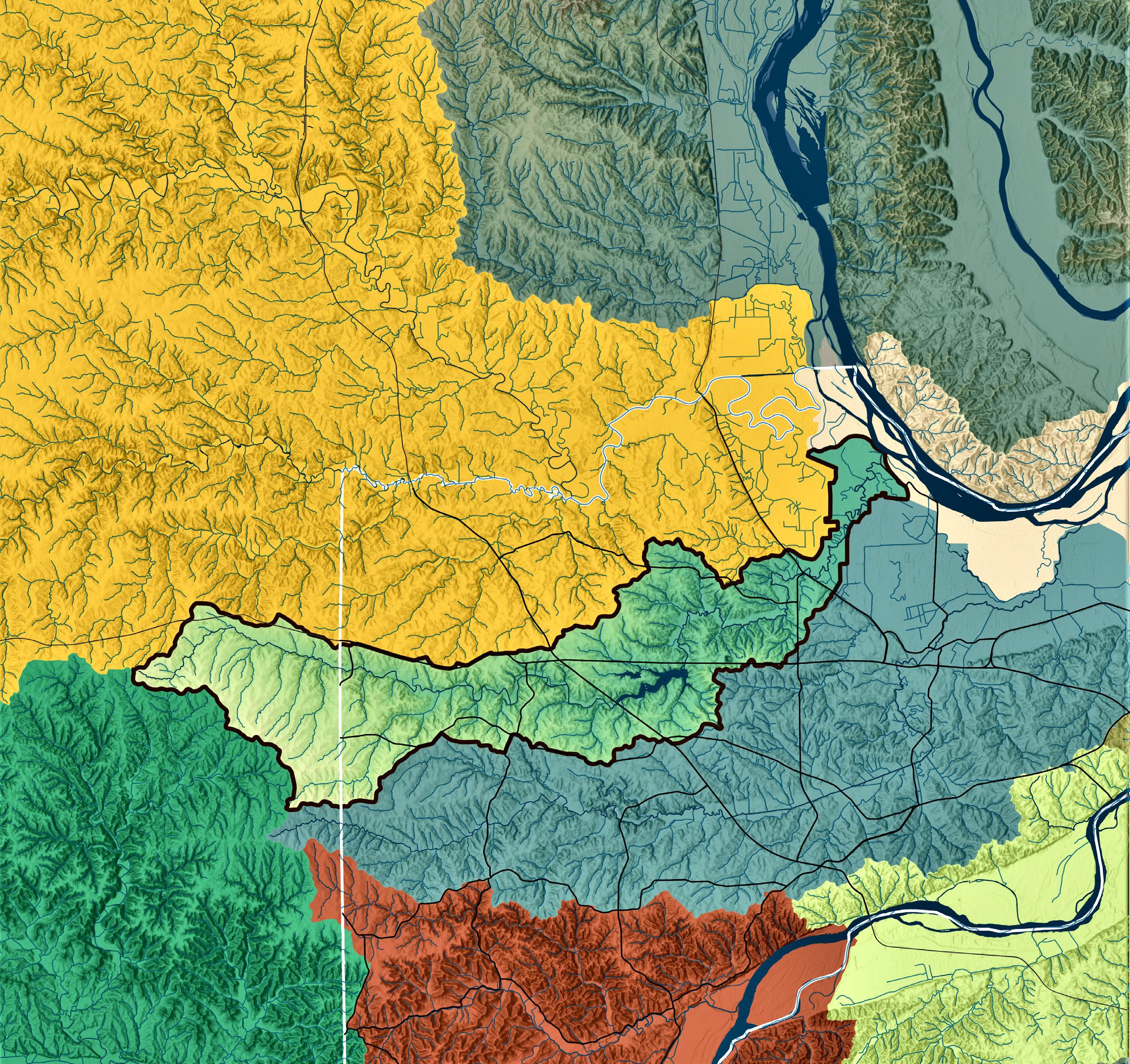
• Drainage Area: 82 sq. mi.









• Length: 56 mi.
• Drains runoff from 10% of the county









• Headwaters: Warren County
• Mouth: Mississippi River
• Creek Elevation Change: 328 ft. (748 to 420 ft.)
Parks and Conservation Areas
(buildings, parking lots,





Forest Shrub, streets, turf grass, etc.)
High Impervious: Urban Medium Impervious: Agriculture


Grass & Wetlands
Low Impervious: 32% 34% 34%


Watershed Land Cover Statisics only represent watershed area within St. Charles County.
Land Cover Data: NLCD 2016
PeruqueCreek 70 70 64 64 79 N 94 94 DD P D Z F K Wright City
1 2 3 4 5
Map Image, Kelly Dunlap
1 Peruque Valley Park
2 Quail Ridge Park
3 Lake St. Louis Boulevard Park
4 O'Fallon Civic Park
5 Dames Park
Guide | 15
St. Charles County Stream Care
Femme Osage Creek and Howell Island










Watersheds















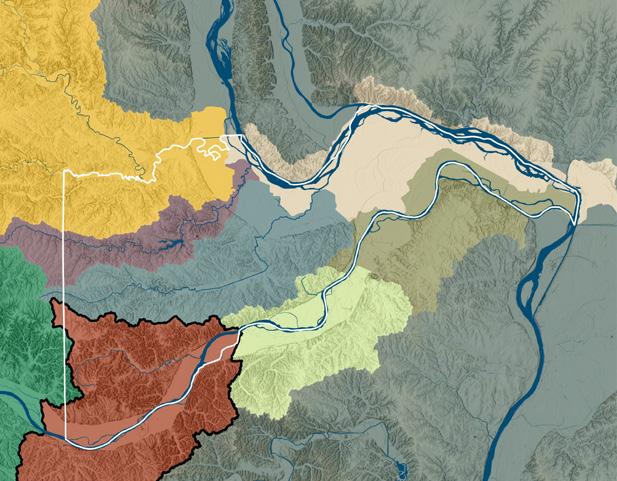



• Drainage Area: 230 sq. mi. • Length: 18.4 mi. • Drains runoff from 20% of the county • Headwaters: Hwy. T & Femme Osage Ridge Rd. • Mouth: Mississippi River • Creek Elevation Change: 441 ft. (901 to 460 ft.) 94 T 64 64 364 N 94 DD D Z F FemmeOsageCreek
Washington 70 Chesterfield K O'Fallon 4 5 2 3 1 Parks and Conservation Areas 1 The Historic Daniel Boone Home at Lindenwood Park 4 Weldon Spring Conservation Area 5 Howell Island Conservation Area 3 Matson Hill County Park 2 Klondike Park Watershed Land Cover Statisics only represent watershed area within St. Charles County. Land Cover Data: NLCD 2016 Augusta High Impervious: Urban Medium Impervious: Agriculture Forest, Shrub, Wetlands & Grass Low Impervious: 32% 17% 60% 16 | St. Charles County Stream Care Guide
Map Image, Kelly Dunlap
•
Duckett Creek and Bonhomme Island Watersheds











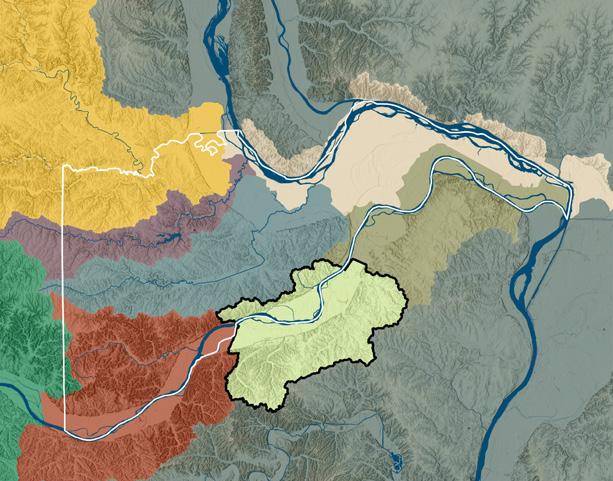
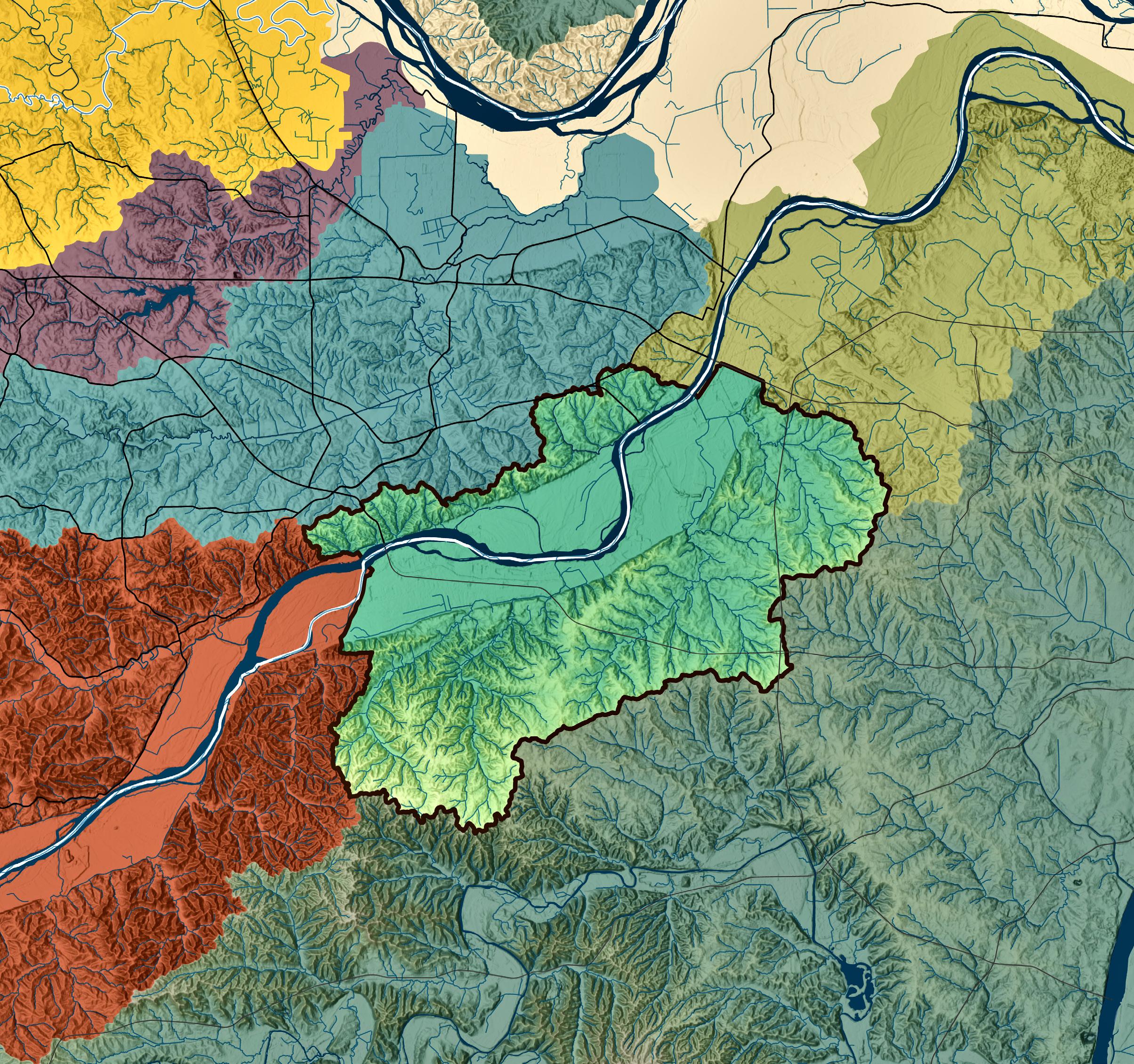
•
•
•
•
•







Drainage Area: 21 sq. mi.
Length: 4 mi.
Drains runoff from 4% of the county
Headwaters: Hwy 94/364 and Harvester Rd
Mouth: Missouri River
Creek Elevation Change: 130 ft. (550 to 420 ft.)
Map Image, Kelly Dunlap Duckett Creek St. Peters 64 364 N 94 DD D Z F 64 St. Peters O'Fallon St. Charles Chesterfield Maryland Heights 70 94 K 270 Parks and Conservation Areas 4 Webster Park 3 Katy Trail State Park Several trailheads including Centennial Trailhead & Greens Bottom Trailhead 1 Busch Greenway Connects Katy Trail to August A. Busch Memorial Area 3 4 1 5 64 364 94 94 Watershed Land Cover Statisics only represent watershed area within St. Charles County. Land Cover Data: NLCD 2016 Medium Impervious: Agriculture Grass & Wetlands Low Impervious: 30% 45% 25% Forest, Shrub, High Impervious: Urban (buildings, parking lots, streets, turf grass, etc.) 5 Heritage Museum 2 2 Missouri Bluffs Park Connects to Great Rivers Greenway Connects to Katy Trail Connects to Katy Trail St. Charles County Stream Care Guide | 17
Cuivre River Watershed


• Drainage Area: 1,235 sq. mi.


















• Length: 41.6 mi.

• Drains runoff from 14% of the county






• Headwaters: Audrain and Pike Counties









• Mouth: Mississippi River
• Creek Elevation Change: 335 ft.
Map Image, Kelly Dunlap Wentzville O'Fallon St. Peters CuivreRiver 70 70 64 64 79 N New Melle Lake St. Louis 94 DD P D Z K 79 Troy Moscow Mill Flint Hill Old Monroe St. Paul Wright City Warrenton Hawk Point 4 Splash Station 5 Progress Park 3 Towne Park 1 Cuivre River State Park 2 Indian Camp Creek Parks and Conservation Areas 6 2 3 1 5 4 6 Cuivre Island Conservation Area High Impervious: Urban Medium Impervious: Agriculture Forest, Shrub, Wetlands & Grass Low Impervious: 32% 17% 51% Watershed Land Cover Statisics only represent watershed area within St. Charles County. Land Cover Data: NLCD 2016 7 Flatwoods Park 7 18 | St. Charles County Stream Care Guide
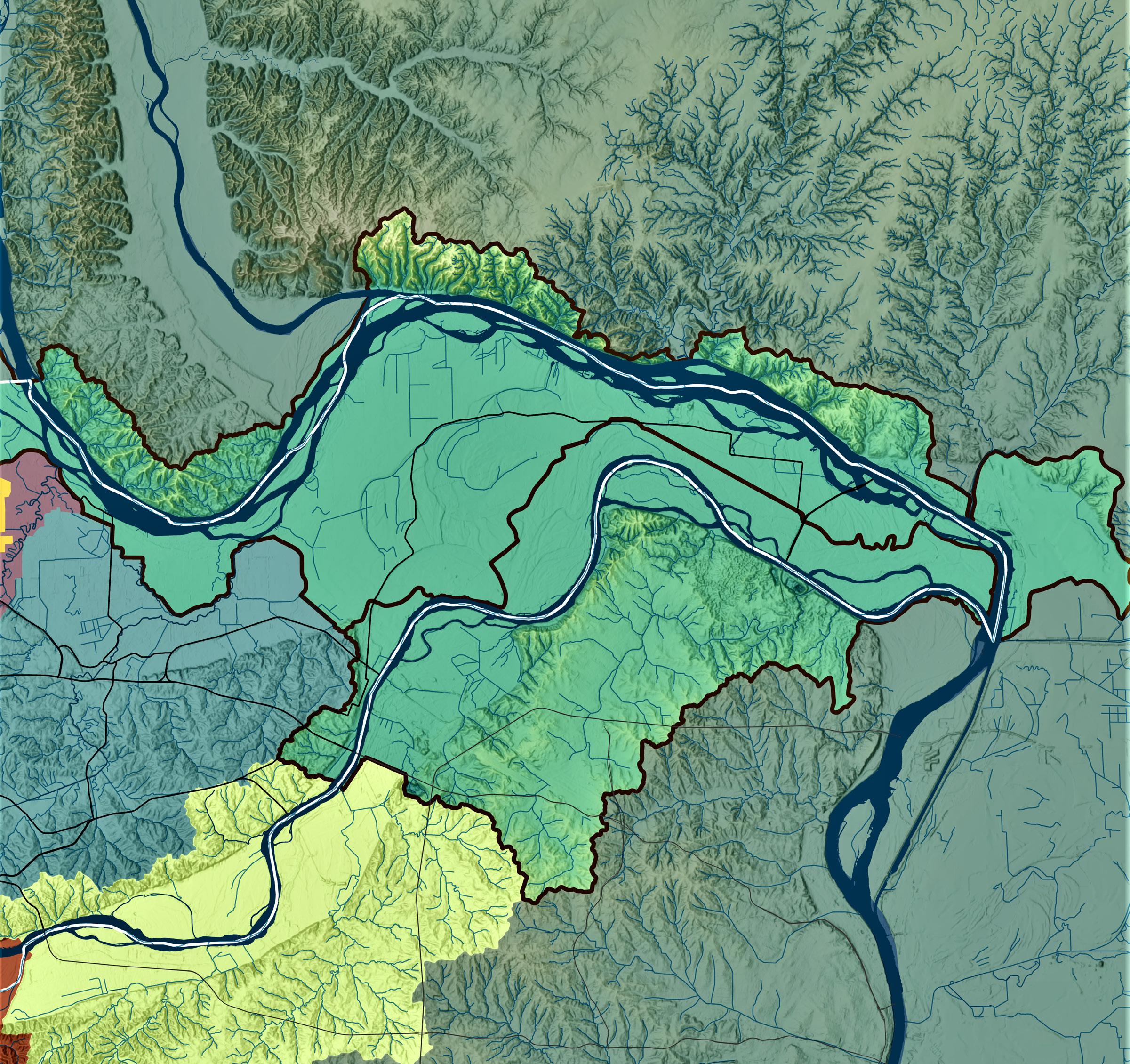

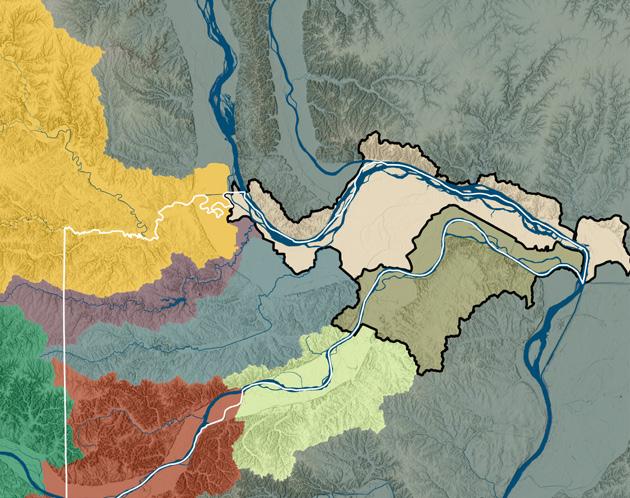








































• Drainage Area: 313 sq. mi. • Drains runoff from 26% of the county
Confluence
Image, Kelly Dunlap 270 2 Frontier Park 3 Blanchette Park 1 Louis H. Bangert Wildlife Area 4 Marais Temps Clair Conservation 6 Pelican Island Natural Area 5 St. Stanislaus Conservation Area 9 Edward and Pat Jones Confluence Point State Park 8 Columbia Bottoms, Missouri 7 Upper Missouri Conservation Area 2 3 1 4 7 6 5 9 8 Watershed Land Cover Statisics only represent watershed area within St. Charles County. Land Cover Data: NLCD 2016 Medium Impervious: Agriculture Grass & Wetlands Low Impervious: 18% 21% 61% Forest, Shrub, High Impervious: Urban (buildings, parking lots, streets turf grass) 10 10 Hideaway Harbor Park St. Charles St. Peters 70 70 364 370 94 Florissant Alton DesPortageSioux St. Charles County Stream Care Guide | 19 Parks and Conservation Areas
Lower Missouri/ Mississippi River
Map
In Our Community
Urban and rural development, farming and other practices can cause serious degradation to stream ecosystems. Harmful chemicals and trash easily move from the community setting to local streams. It’s important to be aware of various strategies we can use to protect our natural resources and local ecosystems.
Low Impact Development
Low Impact Development (LID) is a development strategy that manages stormwater to lessen the impacts of built areas, while protecting water quality and aquatic habitat. LID systems and “green infrastructure” practices use existing natural features or mimic natural drainage processes to capture and retain water as close to its source as possible. This allows time for it to soak into the soil where it is naturally filtered. Implemented broadly, it can mitigate the urban heat island effect, save energy and increase property values. LID practices include:
Tree Preservation and Planting
Natural tree cover significantly reduces the amount of rain reaching the ground (through interception and evapotranspiration), reduces the erosive energy of raindrops and reduces the volume of runoff.
Green Buffers
Native vegetation, especially along stream riparian zones, protects streambanks and channels by reducing erosion, helping absorb and buffer floodwaters, and improving water quality.
Green Roofs
Vegetated roofs absorb significant amounts of rainwater on the flat areas of roofs, reduce energy costs and offer wildlife habitat.
Vegetated Swales
Vegetated swales replace “grey infrastructure” piping and traditional curb and gutters that whisk water away from streets and parking lots. These depressed areas border parking lots and subdivision roads, and are designed to slow and infiltrate runoff.

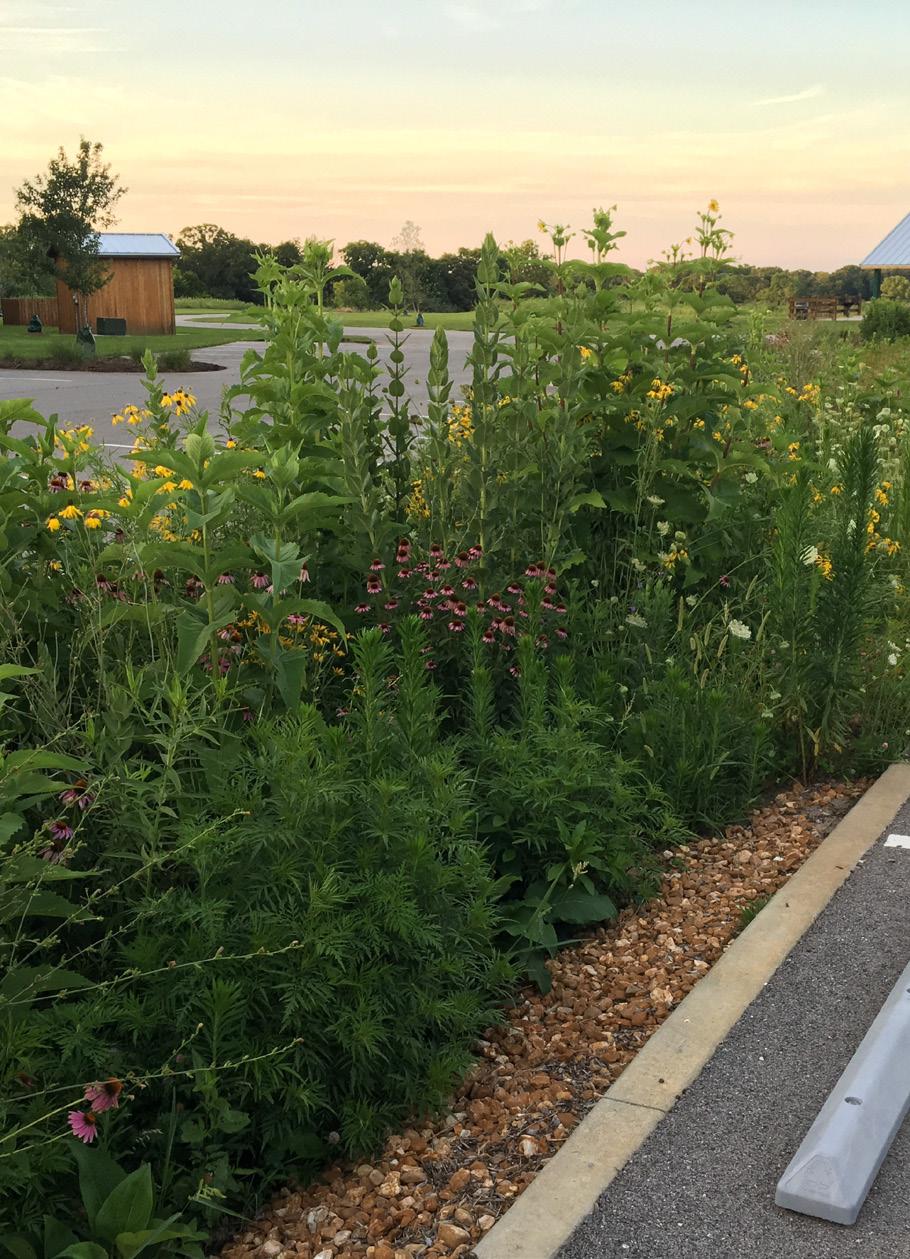
Rain Gardens
Also called bioretention basins, these gardens capture rainwater from downspouts and use plants, soil and gravel layers to slowly infiltrate and filter water, rather than allowing it to run off quickly.
Rain Barrels
These barrels capture and store rain runoff from roof downspouts or other drains. The stored water is then used for plants and lawns during drier periods.
Pervious Pavement
Permeable pavers are typically combined with a gravel bed to soak water into the soil, allowing it to move slowly into other drainage systems.
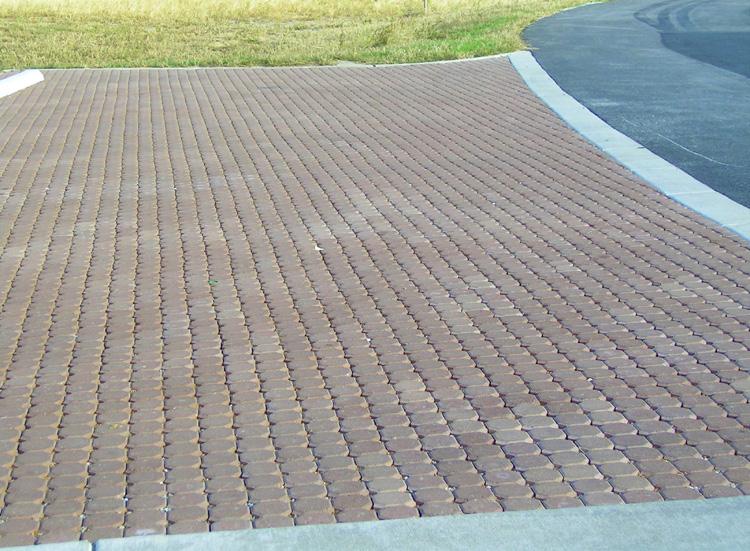
Steps to Protect Water Quality
• Protect important and sensitive conservation areas on the site being developed (wetlands, trees, streams, steep slopes).
• Limit mass grading to the footprint of the buildings whenever possible.
• Disconnect downspouts and reduce impervious surfaces to minimize stormwater volume.
• Create areas for infiltration (native landscaping, rain gardens/ bioretention, bio-swales, pervious pavement).
• Connect multiple systems for a treatment train approach (rain gardens, bio-swales, grass filter strips, ponds, stream buffers).
Pervious pavers, Theresa Strunk
Alberici Headquarters, Jamie Paige
20 | St. Charles County Stream Care Guide
Native plants in LID practice at Indian Camp Creek, Perry Eckhardt
Agriculture and Conservation
To protect local streams, most farmers in St. Charles County adopt management strategies that help protect natural resources.

Crop Strategies
• Use no-till as much as possible. This helps reduce soil erosion and promotes soil health by protecting pore spaces and soil organisms.
• Plant cover crops to reduce erosion and add organic matter back into the soil. See Midwest Cover Crops Council at https://mccc.msu.edu/

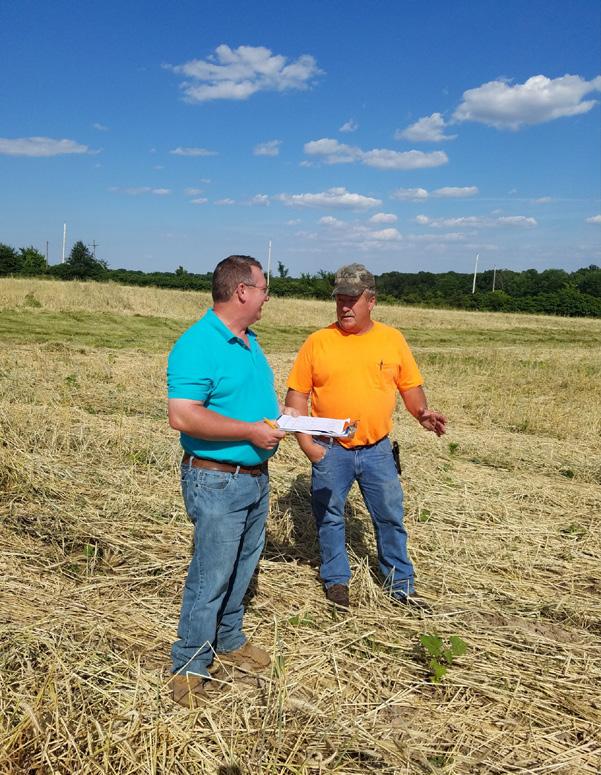
• Repair gullies and ditches in fields by installing grassed waterways or terraces.
• Use less fertilizers and pesticides. Improve crop hardiness and make plants less susceptible to pests and diseases.
Livestock Strategies
• Minimize trampling damage with designated stream access points and crossings that use wildlife-sensitive fencing and appropriate stream bed and bank hardening measures.
• Use alternative watering facilities away from streams.
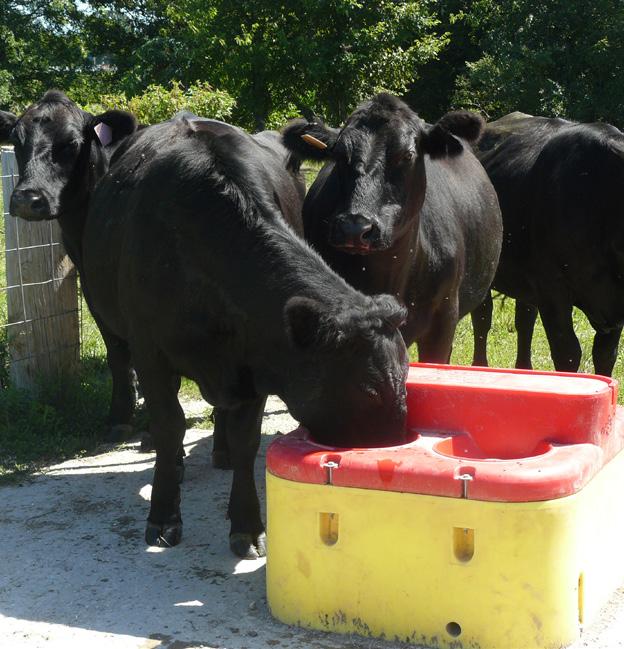
• Plant and maintain a healthy riparian buffer between streams and livestock areas, such as pastures, barnyards, paddocks and manure storage areas, to help filter nutrient-rich runoff.
• Keep horses out of streambeds and off banks. Use designated crossings when possible.
• Collect and compost manure regularly. Keep manure piles and drainage paths 100 feet or more away from streams.
• Use cross-fencing and pasture rotation to prevent over-grazing and soil erosion.
• Use fencing to keep animals from grazing riparian areas.
SWCD & farmer consultation, Theresa Strunk
Cattle near Wentzville, Theresa Strunk
Southwest St. Charles County farm, Perry Eckhardt
St.
County Stream Care Guide | 21
Soybean harvest near Flint Hill, Theresa Strunk
Charles
In Your Backyard
By planning ahead and making conscious decisions on backyard features, you and your neighbors can play a key role in preventing and reducing harm to stream ecosystems. The goal is to balance the needs of your landscape with the needs of the larger ecosystem. Overall, when planning your backyard landscape consider how you can:
1. Reduce runoff by increasing infiltration.
2. Reduce possible pollution sources on my land.
Rethink Your Lawn
Grow Less Turf
You can protect water quality and improve habitat by reducing the total area of mowed/ maintained lawn. Typical lawn grasses, like Kentucky Bluegrass and Fescue, have shallow root systems and require a lot of water to stay healthy and green. In comparison, the deep roots of native plants utilize water more effectively, saving water and decreasing runoff. Lawn grasses require fertilizer and other lawn chemicals, which add to pollutant loads.
Use Conservation Buffers
Ideally, very little water should leave your yard during a rain event. Utilizing rain gardens and bio-swales around the perimeter of your yard will help you reach this goal as well as add beauty to your landscape.
Install a Rain Garden
Rain gardens are shallow, landscaped depressions that naturally slow and filter stormwater runoff. Rainwater from your home’s downspouts can be channeled to the garden where the soil and native plants mimic nature, helping restore a more natural water cycle.
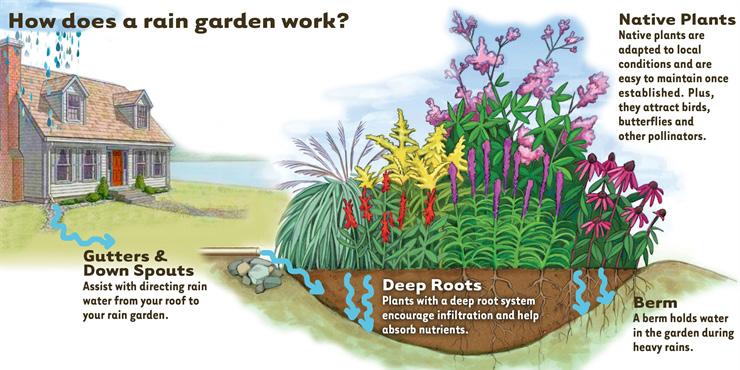
Maintain Stream Buffers
Maintain a robust buffer of native riparian vegetation along streams and drainage areas.
Diverse Species
Growing Turf Grass?
Mow the lawn high for better root production and shading out weed seeds. Leave the clippings to reduce the need for nitrogen by up to one-third.
Test the soil before applying fertilizer.
Areas closest to the water’s edge will experience periodic flooding and more of the stresses associated with higher flows. The plants in this area need to provide stable banks as well as healthy riparian habitat. Ideally, this area would consist of trees and woody shrubs as well as grasses, native flowering plants and other native ground cover. See Native Plants for Piparian Zones on page 30.
Diverse Structure
Multiple layers of vegetation of different heights and structure mean more choices of habitat and shelter for mammals, birds, insects, etc. A diversity of native plants provides the preferred food and cover for wildlife and reduces maintenance costs. See the Riparian Zone on page 8.
Less Landscaping, More Naturescaping
• Plant native trees, shrubs, grasses and wildflowers.
• Use multiple vegetation layers (trees, shrubs and ground covers) to provide better habitat.
• Use porous materials (gravel, mulch) to reduce compacted, impervious areas and encourage water infiltration.

22 | St. Charles County Stream Care Guide
Bumblebee on Butterfly Weed, Theresa Strunk
Be Smart About Placing Structures
Streams continually move and change over time. Floodwaters can eventually undermine structures placed in flood zones and riparian areas. The best way to protect your investment is to avoid putting improvements in these areas. It is an expected and planned part of storm drainage systems in developed areas for most yard swales, streets and common grounds to provide overland flow relief during heavy rains to help keep drainage away from home foundations. In most municipalities, streams have setbacks that require structures to be kept a minimum distance from the stream. See Natural Watercourse Protection Buffers on page 38 for more information on setbacks.
Keep Yard Waste Off Banks and Out of Streams
Debris such as grass clippings, leaf piles, trash and construction material stored on streambanks eventually smothers and kills existing riparian vegetation. It is common for this debris to worsen existing erosion. Riparian vegetation is vital to a stream’s overall health. Serious problems can arise when debris gets into the stream.
Stream levels can rise dramatically during storm events, washing debris downstream. Debris can block culvert openings and get hung up on bridges, causing flooding and property damage. In addition, excess amounts of organic matter (grass, leaves, etc.) deplete dissolved oxygen in water, causing serious impacts on fish, insects and other aquatic life. See Yard Waste on page 39 for disposal options.
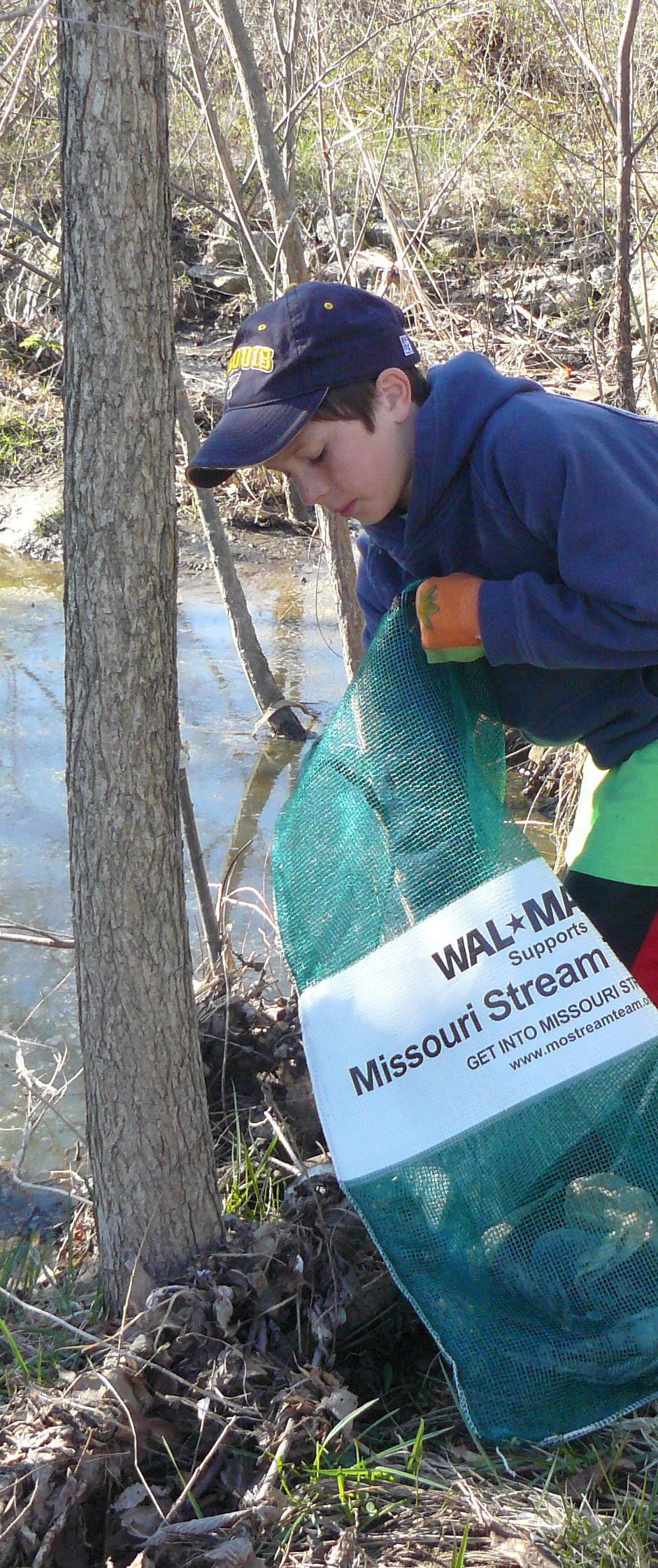
Pick Up After Your Pet
No one likes smelling or stepping in poop, but did you know un-scooped poop presents serious issues for water quality and human health?
The Facts
• Pet waste is raw sewage. It can transmit bacteria, viruses and other pathogens to humans and animals, including roundworm, E. Coli, giardia and salmonella.

• Pet waste in yards, parks and on sidewalks gets into lakes, streams and rivers, even into groundwater.
• Nutrients in pet waste cause excess algae growth in lakes and streams. When algae decays, it depletes oxygen in the water that is essential for fish and aquatic life.
What You Can Do
• Scoop weekly to keep your yard clean.
• Bring baggies when walking your pet, plus extras to share.
• Seal the bags and toss them in the trash.
• Never use pet waste in your garden or compost.
Help Tackle Litter
• Trash on the ground, anywhere in the watershed, may potentially end up in nearby streams and rivers.
• Dumping any sort of trash, or yard waste, is restricted in all communities within the county, and often is enforced with a significant fine.
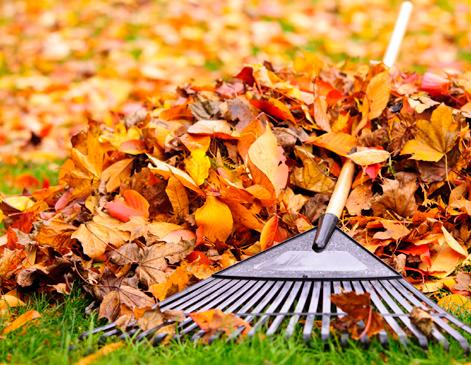
• Important infrastructure can become clogged and damaged, increasing the chances of flooding and pollutant contamination of water resources that are used for drinking water. This can be a costly problem.
• Thank you for helping pick up trash in our community!
Mission: Clean Stream, Theresa Strunk
St. Charles County Stream Care Guide | 23
Theresa Strunk
The Storm Drain Connection
Unlike sanitary sewer systems that flow from your home to a treatment plant, the separate storm drainage system sends stormwater runoff directly into local streams, rivers and lakes. It can carry fertilizer, pet waste, mud, oil and other chemicals from lawns, driveways and roads into surface water bodies without filtration or treatment.

Tips to Keep Pollution Out of Storm Drains
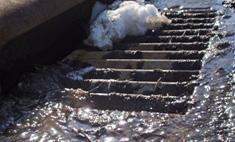
Landscape
• Mow lawns 3” or higher for deep and healthy roots to reduce irrigation needs and runoff.
• Mulch or compost yard debris (grass, leaves, etc.) and keep debris out of the storm drain.
• Keep fertilizers and garden chemicals off driveways and sidewalks. Sweep up any excess.
• Adjust sprinkler heads to spray only lawn and garden areas, not driveways and roads.
• Use only as much fertilizer as needed, preferably natural/biodegradable products.
• Use natural/non-toxic methods to control garden pests. If pesticides or herbicides are needed, check with local nurseries for products that are registered for use near water.
• Use native and drought-tolerant plants to reduce the need for fertilizer and watering.
Household
• Pick up after your pet. Their poop is not a natural fertilizer; it’s bad for water quality and human health. Bag and trash it!
• Never dump household toxics (paint, cleaning products, engine oil, antifreeze, pesticides, medications, etc.) down the storm drain. Check the label and/or call Recycle Works for proper disposal. See page 39.
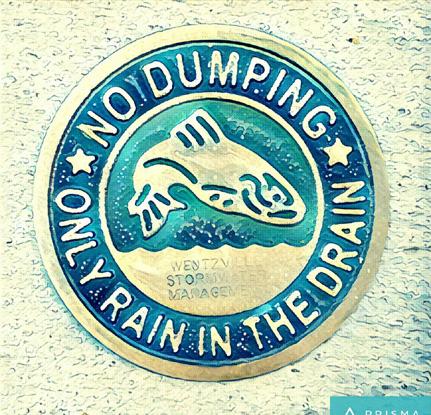
• Wash your car on the lawn, using phosphate-free soap. Even better, use a commercial car wash.
• Sweep dirt into the garden (don’t wash down the storm drain).
• Put debris in the trash and make sure the trash container is properly covered and sealed.
• Minimize impervious surfaces on your property.
• Drain pool or spa water onto a lawn that can absorb it without runoff. To drain into your sewer clean-out (not storm drain!), contact your local sewer district for regulations, or call a professional.
• Use sediment controls during construction, such as silt fences or straw bales, to keep soils onsite and out of the storm drain.
North Carolina
of Environmental
Department
Quality
24 | St. Charles County Stream Care Guide
Jamie Paige
Be Smart about Septics
Septic systems (also called onsite wastewater systems) are underground wastewater treatment structures used to treat household wastewater in areas without centralized sanitary sewer systems. A typical onsite system consists of a septic tank and a drainfield (or leachfield). Solids settle-out in the tank and liquid wastewater (effluent) flows to the drainfield where it percolates into the soil. The soil absorption process naturally removes harmful coliform bacteria, viruses and nutrients.
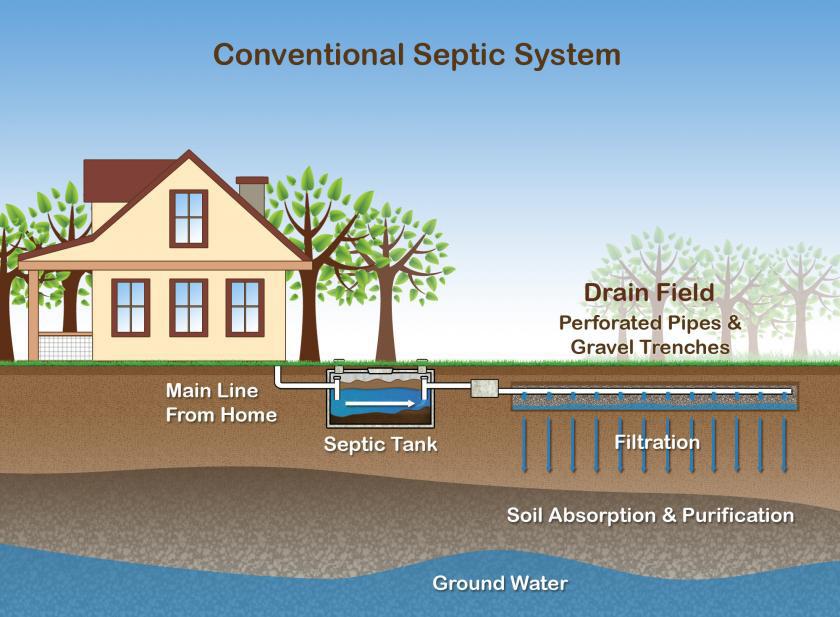
If you have a septic system, it’s extremely important to keep up with its proper care and maintenance. This is especially true for streamside properties where proximity to the stream and potential for periodic flooding must be carefully considered. There are concerns with water quality anytime onsite wastewater systems are less than 150 feet from waterways, especially with regard to aging systems and those built before stricter regulations. The current minimum setback in the county is 50 feet. Refer to St. Charles County Building Code Enforcement ONSITE WASTEWATER TREATMENT SYSTEMS (OWTS) webpage for information at www.sccmo.org.
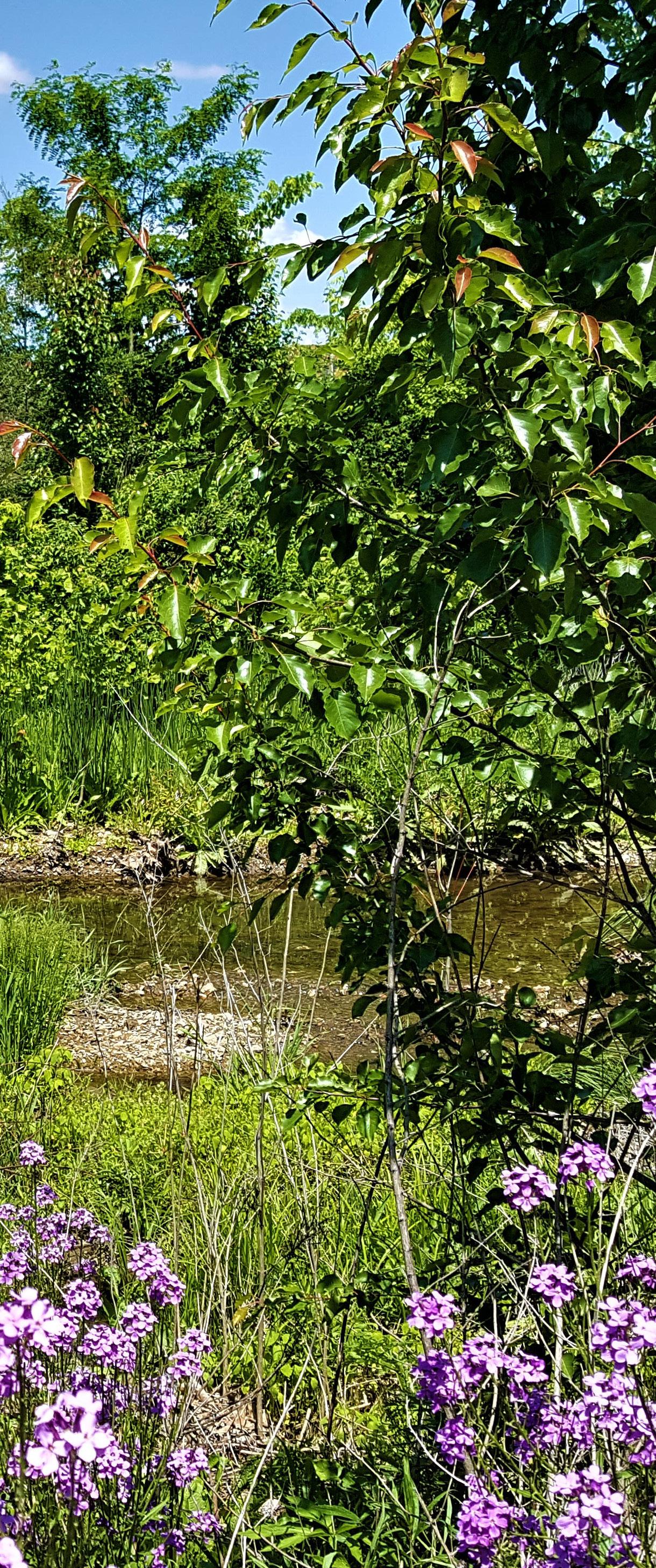
Caring for Your Septic System
• Pump your tank. Septic tanks should be pumped every two to three years to prevent solid material from entering lateral lines and blocking fluid movement.
• Only human waste and toilet paper should go in the toilet. Other items may travel into lateral lines.
• Use liquid, low phosphate detergents. Solid detergents only liquefy when agitated, then solidify again.
• Keep finished grading below the bottom of lids. Maintain lids above the finished grade, including mulch or other landscaping to prevent mud and rain infiltration.
• Avoid driving or pasturing animals on lateral lines and drain fields. Soil compaction reduces its absorbent qualities.
• Do not run water softener through your septic system. Salt water kills micro-organisms and the bacterial action needed for proper functioning.
• Run roof drains away from laterals and drain fields. Saturated soil may cause effluent to rise to the surface.
• Monitor water usage. Space out laundry, use a low-volume water toilet, install a low pressure shower head, and repair all plumbing leaks for more efficient water use.
• Avoid garbage disposals. Many items can cause system failure, such as coffee grounds, egg shells, raw vegetables, meat and grease that can clog perforated holes in drain field pipes.
St. Charles County Stream Care Guide | 25
Crossroads Creek, Jamie Paige
Native Plants: A Smart Choice
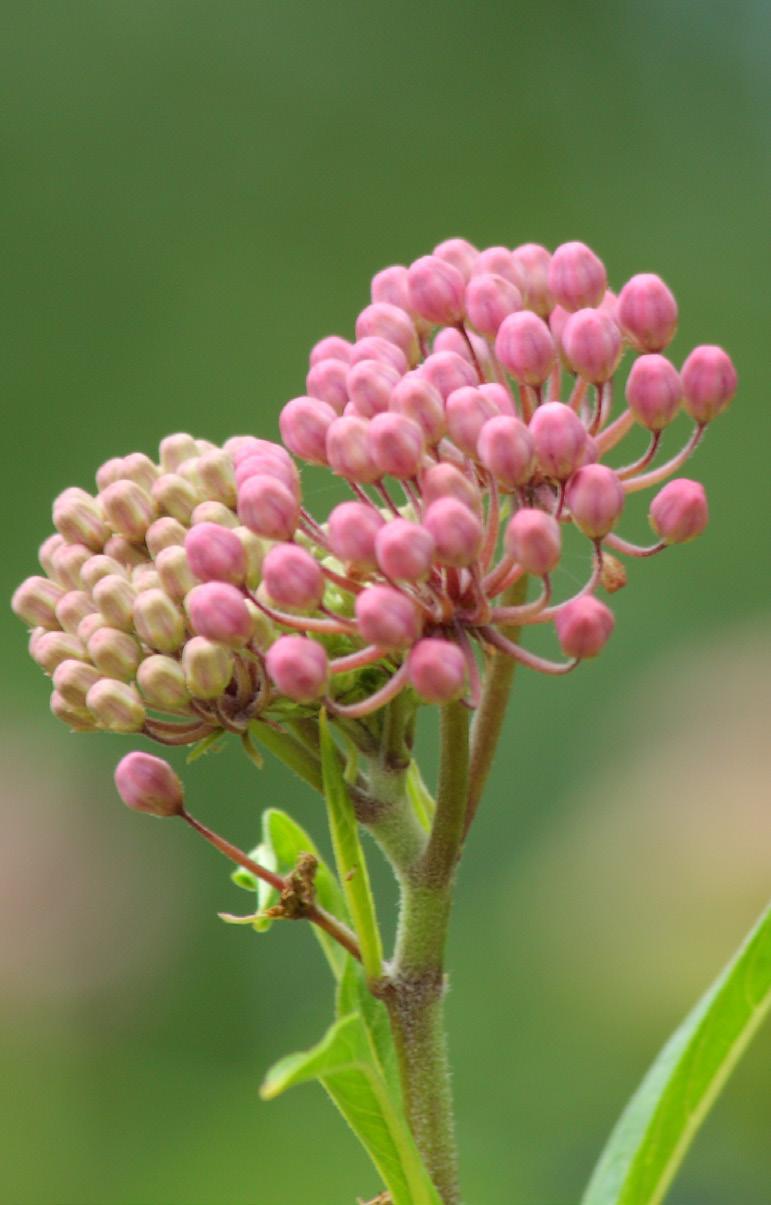
Missouri’s native plants are a smart choice for your yard. Not only do native plants create beauty and interest with a progression of flowers and fruit, they also provide food and cover for butterflies, birds and other wildlife. Native plants offer benefits for streamside landowners by filtering runoff and providing erosion control along streambanks.
Residents can work toward a more natural plant community in their own backyards, one plant at a time. Whether it is a Missouri tree, shrub, grass or flower, planting natives will improve habitat for native animal species and assist in ecosystem services such as pollination, disease and pest control, water purification and more. Diverse native plant communities along waterways and roadsides slow water movement and help prevent flooding more effectively than mown turf. See additional resources on pages 39-40.
Why Native Plants Matter

When considering stream health, native plants along streams are important because their deep roots assist with managing stormwater runoff and soil erosion. Native plants are also beneficial because:
• They have been in Missouri since the last Ice Age, more than two million years ago.
• They evolved with Missouri’s geology, climate and wildlife.
• They are preferred food and shelter for many wildlife species.
• They help resist invasive non-natives that threaten wildlife habitat and crops.
• They sustain hundreds of species of pollinators.
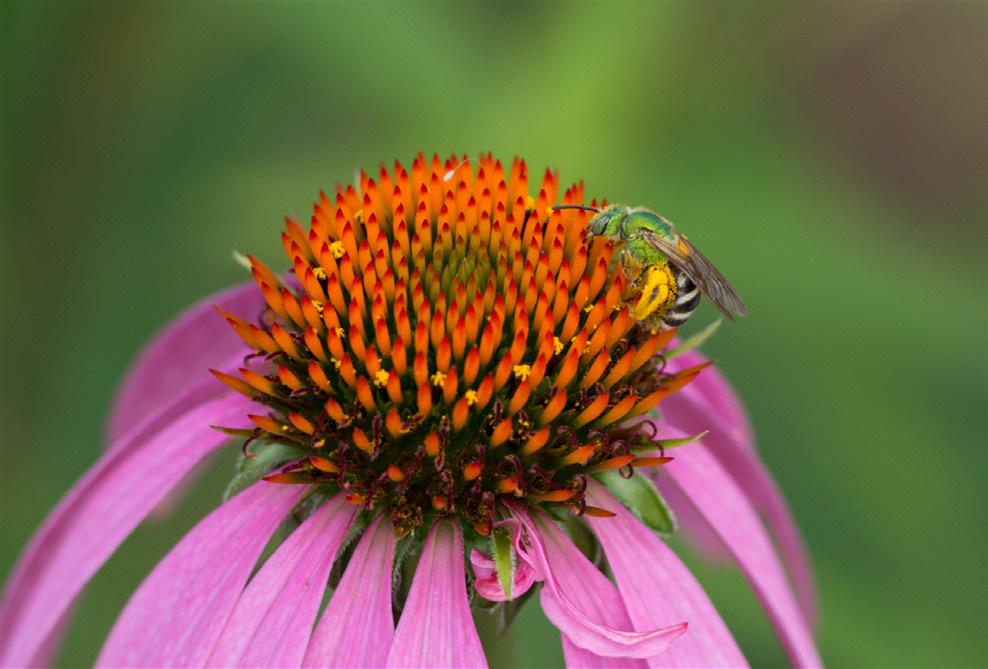
• They are necessary to the migration of Monarch butterflies.
• They beautify your surroundings and fill your landscape with life and color!
When Choosing Plants, Consider:
• Sun/shade percentage
• Water movement on the land (slope)
• Soil type
• Overhead wires or obstructions for growth
Spider on Black-eyed Susan, Theresa Strunk
Swamp Milkweed, Perry Eckhardt
26 | St. Charles County Stream Care Guide
Sweat bee on Coneflower, Perry Eckhardt
Selecting Plants
Missouri is enriched with a diverse community of native plants and animals that thrive in our state’s climate and geological history. The success of a plant species in the landscape depends on geology, soil types, water flow patterns, topography, slope, current and historic vegetation patterns and the impacts of humans on the land.
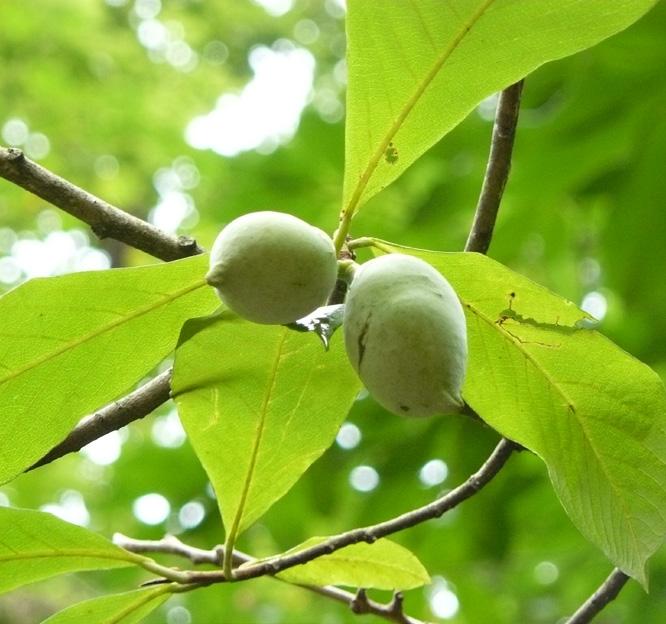
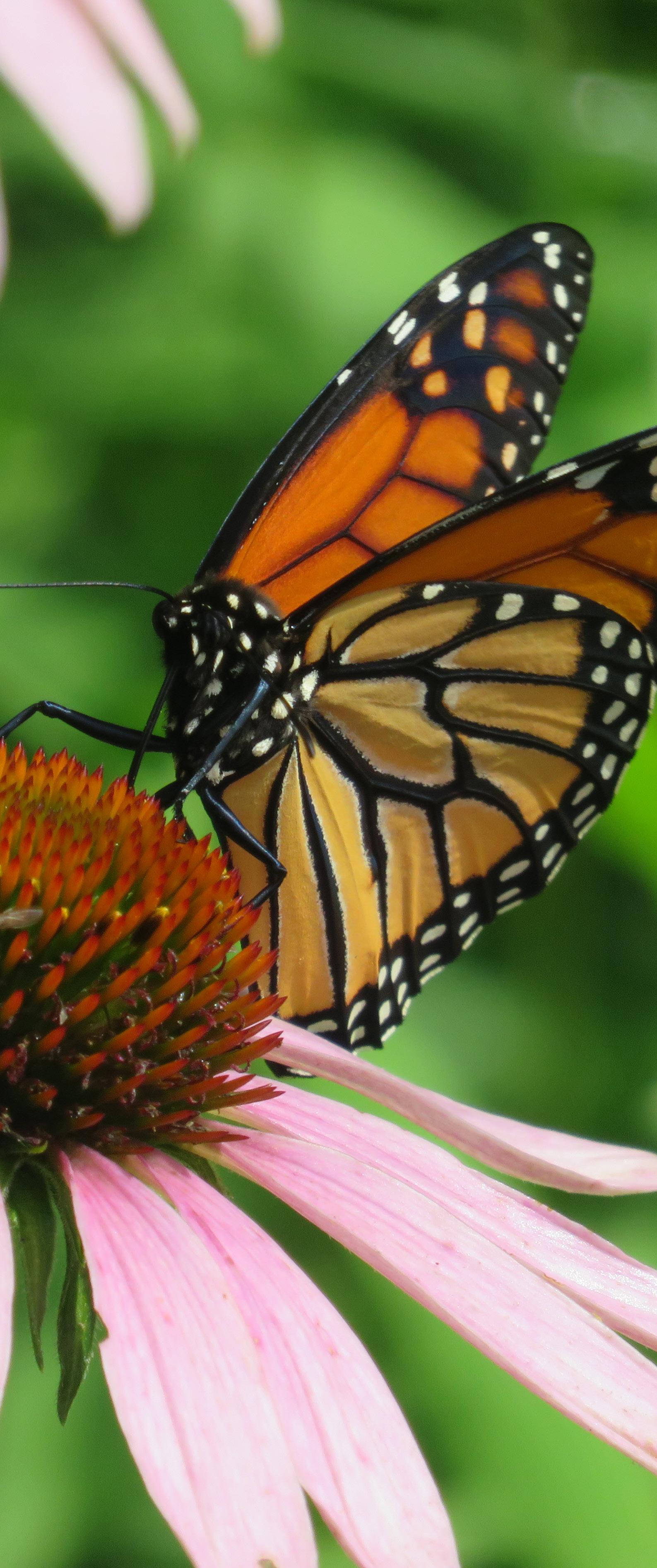
Do You Know Missouri's Nine Major Natural Community Types?
Forest – Large area with closed canopy and layers of subcanopy trees, shrubs, vines, ferns and herbs.
Woodland – Area with 30 to 100 percent canopy, with an understory of shrubs, grasses, wildflowers and sedges.
Savanna – Grassland interspersed with sun-loving shrubs and less than 30 percent tree cover.
Prairie – Perennial deep-rooted grasses, with scattered shrubs and less than 10 percent trees.
Glade – Open, rocky, area with drought-adapted flowers, warm-season grasses, and unique animals.
Cliff and Talus – Steep cliffs, rocky slopes and sparse vegetation of ferns, wildflowers, lichens and mosses.
Stream Edge – Sandbars, gravel washes, streambanks and riverbanks with water tolerant species including some trees.
Wetland – Saturated soils with fluctuating surface water dominated by water-loving plants.
Cave – A natural opening in the earth where plants do not grow beyond the reach of sunlight.
A great variety of plant communities exist in St. Charles County. The southwestern portion, and some tracts along the Missouri and Mississippi rivers, retain a semblance of historic native natural plant communities. Population growth, development and invasive plant species have greatly changed the landscape in most other parts of the county, leaving “islands” of restored natural communities in parks and conservation areas.
Mowing and Weed Control Tips:
Follow local mowing or weed ordinances. Use a diversity of plants for variety in plant height and growth rate.
Ask if your city or county code enforcement requires prior plan approval for native landscaping.
Native Plant Databases
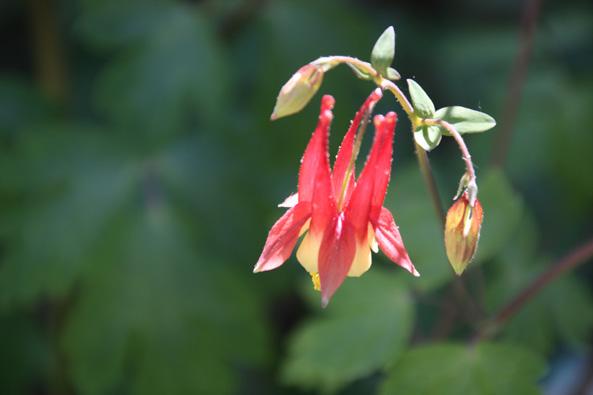
Narrow the hunt with these fun-to-use online search tools. Choose criteria to meet your needs, such as color, height, sun and watering requirements.
www.grownative.org
www.missouribotanicalgarden.org
Monarch Butterfly on Purplee Coneflower, Theresa Strunk
Columbine bloom, Theresa Strunk
Paw-Paw fruit, Theresa Strunk
St. Charles County Stream Care Guide | 27
What’s Wrong with Non-Natives?
Planting non-native species is risky, both for the plant and the health of the ecosystem in which it is placed. Many non-native plants also are invasive, meaning they will crowd out other plants, displacing native flora and fauna. St. Charles County’s top invaders are:

A Word About Weeds
Alien Invaders

Exotic, alien or non-native species describe plants and animals or other organisms that have been introduced into an area outside of their origin.
There are a number of aggressive weeds that have invaded the landscapes of St. Charles County. Most are non-native plant species that were originally planted for ornamental or agricultural uses. As these plants naturalize into local ecosystems, their seeds move up and down stream corridors carried by water, wind and wildlife. With a lack of native controls (insects, disease, etc.), the most successful invasive weeds will ultimately displace native plants and become the dominant vegetation. This has serious impacts on ecosystem health by decreasing biodiversity (the variety of life) and ultimately contributing to increased erosion potential.
Many invasives are listed as noxious weeds, a legal designation by federal, state or county governments for plants considered to be injurious to public health, agriculture, recreation, wildlife or property. But not all invasives are listed as noxious. Regardless of their classification, you should never plant or maintain invasive plants. You should always seek to eradicate them from your landscape!
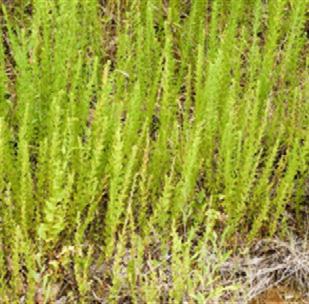
Invasive Plant Control
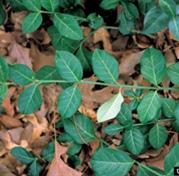

In areas of light infestation, remove by hand when the soil is moist. When too numerous, chemicals may be needed. Other methods may include cutting and herbicide treatment, prescribed burning, and biological controls such as the targeted use of natural pests. For identification and control recommendations for specific non-native, invasive plants, consult the Missouri Department of Conservation or the Missouri Invasive Plant Task Force.
Publications
The Missouri Department of Conservation (MDC) works with the Missouri Prairie Foundation and Grow Native to promote the eradication of non-native, invasive plant species. MDC offers free publications to aid residents in making smart plant choices for their yards.
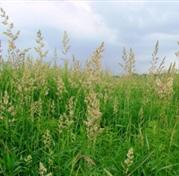
To learn more, visit www.mdc.mo.gov and click on the "Trees & Plants" tab or type "invasive plants" in the search bar.
You can download "Native Plants for Your Landscape" at www.mdc.mo.gov/trees-plants/native-plants-your-landscape.
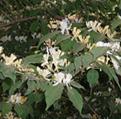
 Callery Pear Bush Honeysuckle Johnson Grass Sericea Ledpedeza Winter Creeper Reed Canary Grass
Callery Pear Bush Honeysuckle Johnson Grass Sericea Ledpedeza Winter Creeper Reed Canary Grass
28 | St. Charles County Stream Care Guide
Bush Honeysuckle, Theresa Strunk
Replace Non-Native Plants with Missouri Natives
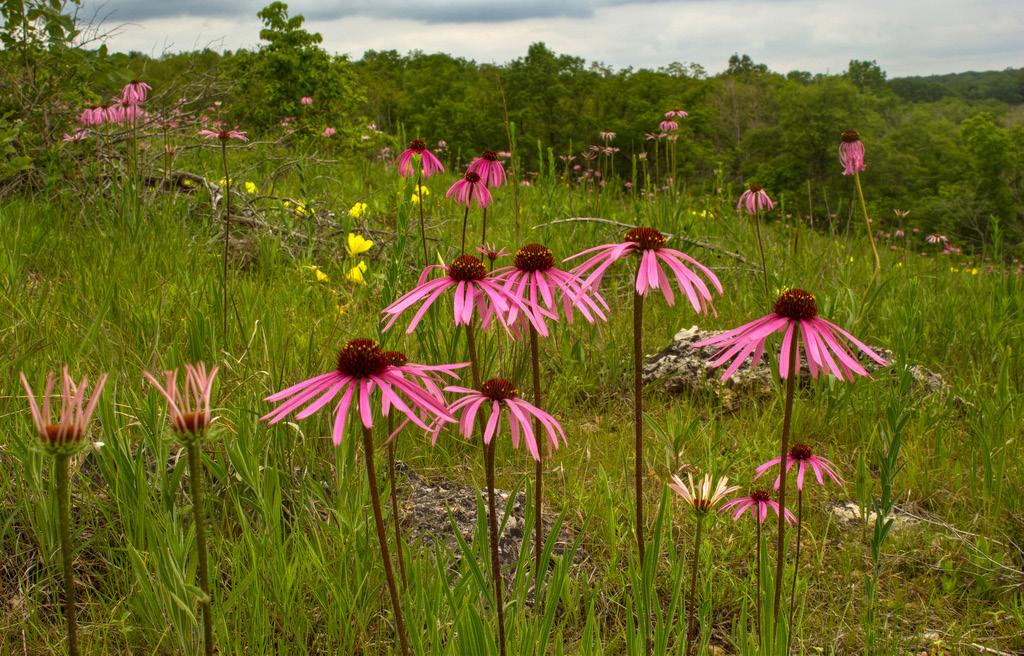
The next time you’re ready to select plants for your landscape, think native. The non-natives listed on the left in the table below are also invasive. When they escape into natural areas — and they do — they harm Missouri’s wild ecosystems. Removal of these invasive species and replacement with plants that are native to Missouri is recommended. Native plants are beautiful, adapted to Missouri’s climate, need minimal maintenance and provide food and shelter for desired wildlife.
The table below lists problematic non-native species on the left. The native Missouri plants on the right are good substitutes for the non-native species.
Problematic Non-Natives
Autumn Olive (Elaegnus umbellate)
Bush Honeysuckles (Lonicera x bella, Lonicera maacki)
Burning Bush; Winged Euonymus (Euonymus alatus)
Butterfly Bush (Buddleja davidii)
Beneficial Natives
Service Berry (Amelanchier arborea)
American Beauty Berry (Callicarpa americana)
Wahoo (Euonymus atropupureus)
New Jersey Tea (Ceanothus americanus)
American Plum (Prunus americana)
Chokecherry (Prunus virginiana)
Callery Pear (Pyrus calleryanna)
Eastern Redbud (Cercis canadensis)
Flowering Dogwood (Cornus florida)
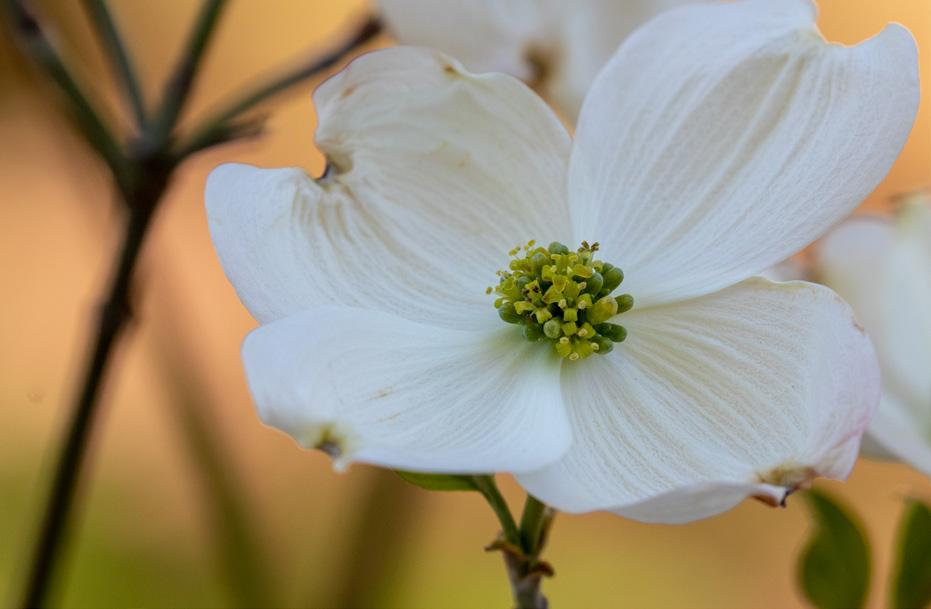
Hawthorn (Crataegus spp.)
Serviceberry (Amelanchier arborea)
Chinese Bittersweet (Celastrus orbiculatus)
Dame’s Rocket (Hesperis matronalis)
American Bittersweet (Celastrus scandens)
Garden Phlox (Phlox paniculata)
Wild Ginger (Asarum canadense)
Garlic Mustard (Alliaria petiolata)
Northern Sea Oats (Chasmanthium latifolium)

Mayapple (Podophyllum peltatum)
Globe Sedge (Carex grayii)
Purple Loosestrife (Lythrum salicaria)
Wintercreeper (Euonymus fortunei)
Yellow
Marsh Milkweed (Asclepias incarnata)
Blazing Stars (Liatris spp.)
Wild Ginger (Asarum canadense)
Southern Blue Flag (Iris virginica v. shrevei)
Flag Iris (Iris pseudacorus)
Purple Coneflower, Perry Eckhardt
Northern Sea Oats, Theresa Strunk
St. Charles County Stream Care Guide | 29
Flowering Dogwood, Perry Eckhardt
Native Plants for Riparian Zones
The charts on these pages feature native trees, shrubs and groundcover species that are adapted to soil and moisture conditions in St. Charles County.
Species listed for low and mid-bank planting zones are most useful for streambank restoration. Those suited for upland areas are best planted in the riparian zones above the top of bank. To help refine plant selections, refer to the Missouri Botanical Garden’s Plant Finder database at www.mobot.org.
Large (Canopy) Trees
Full Sun
Partial Sun
Fast Growing
Moderate Growing
Slow Growing
to Mid Bank Beautify contrasting innerbark. Not suitable near homes; cotton-like seeds in spring, leaves and seed balls in summer. Tolerates wet soil, drought.
Bank to Upland Can live over 1,000 years. Easily adapts to a wide range of sites. Young trees grow rapidly, reaching 20’ tall in 10 years.
to Upland Grows on deep, moist soils.
rapidly on deep, rich, alluvial soils; growth rates decline rapidly in poor soils.
on a variety of soils, dry uplands and moist lowlands.
easily with suckers, yellow spring flowers and brilliant red and orange folliage in fall. Grows best in deep, well-drained bottomlands.
Bank to Upland Grows well on sites wet to dry, on poorly drained and heavy bottomlands.
Bank to Upland Fast growing; adapts well to clay and poor drainage. Shellbark Hickory (
Bank to Upland Grows best in rich bottomland soils.
Bank to Upland Despite its name, does not naturally grow in swamps. Adaptable to a variety of sites.
Excellent for wildlife and windbreak planting.
Birds eat the fruit and larvae of the hackberry; butterfly only feed on its leaves.
Easy to establish, tolerant of urban soils.
Easy to establish, tolerant of urban soils.
How to Plant Livestakes (Cuttings)
Some trees and shrubs, such as cottonwood, willows, and dogwoods can sprout roots and leaves from a livestake, a stick-like cutting roughly 18” long taken from a live plant. When dormant, use a mallet to drive the majority of the cutting into the soil, only leaving two to four inches (about two buds) out of the ground. Plant cutting with buds pointed upward.
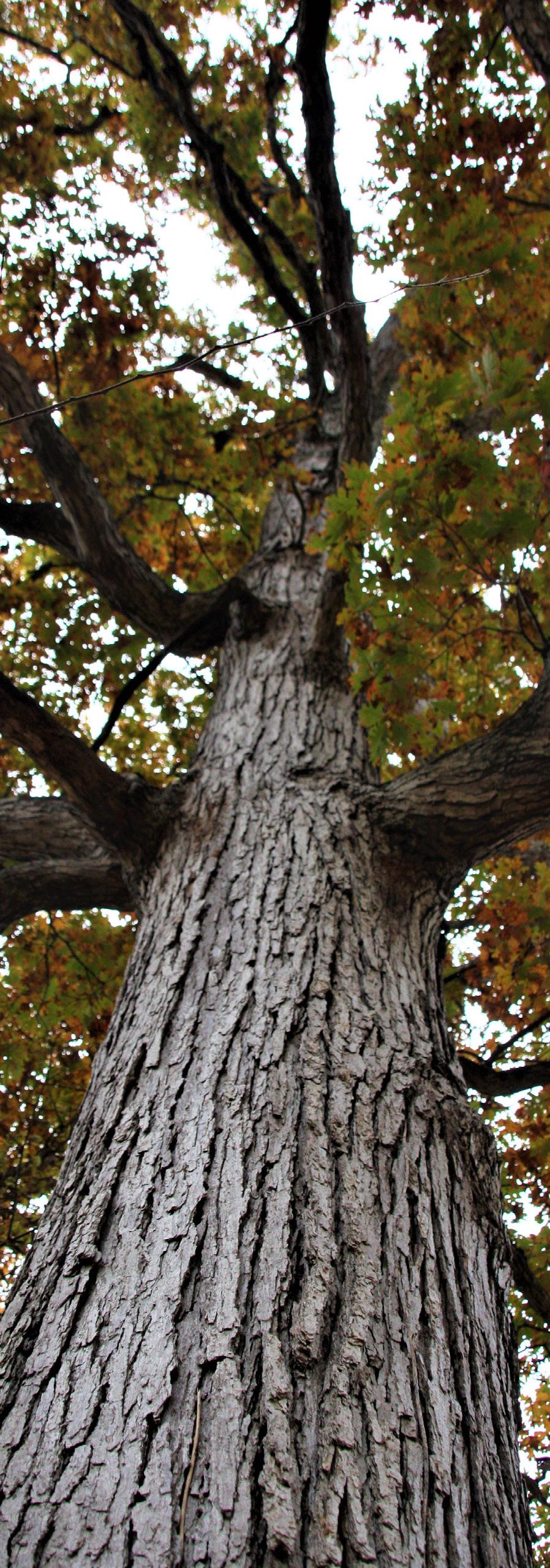
*Suitable for livestaking
Plant Name Mature Height (ft.) Sun Growth Rate Planting Zone Comments Sycamore* (Platanus occidentalis) 75-100 Low
Bald Cypress (Taxodium distichum) 90-100 Mid
Gum (Nyssa sylvatica) 40-65 Mid Bank
Black Walnut (Juglans nigra) 50-75 Mid Bank
Upland Grows
Bur Oak (Quercus macrocarpa) 80 Mid Bank
Upland Grows
Eastern Cottonwood* (Populus deltoides) 50-100 Mid Bank
Spreads
) 60-80 Mid
River
nigra) 0-60 Mid
) 60-80 Mid
Quercus bicolor) 50-80 Mid
Eastern
(Juniperus virginiana) 30-50 Upland
Hackberry
Celtis occidentalis) 45-70 Upland
Red
(Quercus rubra) 60-80 Upland
Shumard Oak (Quercus shumardii) 80-100 Upland
Black
to
to
to Upland
Pin Oak (Quercus palustris
Birch (Betula
Carya laciniosa
Swamp White Oak (
Red Cedar
(
Oak
Oak Tree, Theresa Strunk
30 | St. Charles County Stream Care Guide
Sedges (Oak, Yellow-Fruit, Gray, Pennsylvania) (Carex albicans, annectens, grayi, pensylvanica)
Varies Many species provide excellent scour protection. Spreads by rhizomes. Use as a border or between species for mulch or weed control.
Low-Mid Bank Attractive flat flower spikes hang from stems. Caterpillars feed on leaves. Self-sows prolifically for erosion control. Tolerates poor soil. Slender Rush
Low-Mid Bank Clump-forming, grass-like. Withstands light foot traffic. Salt tolerant.
Bank Performs well in standing water up to 4” deep or in consistently moist soils. Plants are self-seeding and propagated by seed or division.
Bank Fragrant flowers; long periods of attractive fall color. Forms dense colonies by root suckering in moist/wet areas.
Bank to
Easily grown, non-poisonous shrub spreads by root suckers. Tolerates poor soil. Yellow flowers and brilliant shades of foliage in autumn.
v.
Bank to Upland Vigorous, tough rhizomes are excellent for soil-holding. Sword-shaped leaves. Many colors. Plants grown mainly by division.
Bank to Upland Excellent for wetland plantings along sloughs and stream edges. Large, showy white and sometimes pink flowers grow 4-5" in diameter.
Small, non-spreading, clump-forming grass. Blue-green leaves turn reddish orange in fall. Fluffy silver seed heads are ornamental through winter.
Thicket forming shrub; quick to establish and spread; good soil binder and bank stabilizer.
Bank Forms large colonies along dry, gravelly streambeds. Fragrant yellow to red blooms in late fall. Good for borders and informal hedges.
to Upland White flowers; blue fruit for birds. Branches may form roots at the tips when they reach the ground; thicket-forming if not pruned.
Bank Attracts many butterflies, insects and birds. Thrives in humusy soils and tolerates standing water.
Bank White flower clusters in spring with purple/red fall color and black autumn berries. Root suckers create colonial spread.
Bank to Upland Prefers well-drained soil and part shade, but adapts to many conditions. Forms a tall hedge or screen. Tolerates drought, clay. White flowers, purple berries enjoyed by wildlife. Showy fall foliage turns shades of red and purple.
Mid Bank to Upland Found in open woods and along stream borders. Large, showy white flowers with edible purple fruit clusters in fall. Thicket forming.
Bank to Upland Massive root system forms quickly. Ornamental white flowers and mature exfoliating bark resembles the number nine. Tolerates drought, wet, clay and rocky soil. Possum
Mid Bank to Upland Deciduous holly occurs on limestone glades, along sloughs and swamps. Orange-red berries in fall provide winter color attracting small mammals, birds and deer.
Upland Root suckers are thicket forming; tolerates clay soil and black walnut; catkins are showy in spring, flowers in summer turn to edible nuts Blue False Indigo
Upland Best grown in sun with well drained soils. Tolerates drought. Develops slowly expanding clumps with deep and extensive root systems.
Upland
Dense shrub, shedding bark and showy clusters of coral to purple berries persist through winter. Spreads by suckering/rooting nodes where it touches the ground.
Upland Beautiful purplish red flower clusters in the spring lead to large heart-shaped green leaves that turn yellow in fall.
Plant Name Mature Height (ft.) Sun Growth Rate Planting Zone Comments
1-3
River Oats (Chasmanthium latifolium) 2-4
0.5-1
Soft
(Juncus effusus) 2-4
Virginia
(Itea virginica) 3-5
Fragrant Sumac (Rhus aromatica) 2-6 Mid
Upland
Iris (Copper, Southern Blue Flag) (Iris fulva, virginica
shrevei) 2-3 Mid
Rose Mallow (Hibiscus lasiocarpos) 4-8 Mid
Little Bluestem (Schizachyrium scaparium) 2-3 Upland
Plant Name Mature Height (ft.) Sun Growth Rate Planting Zone Comments Willows (Peach-leaved, Sandbar, Slack, Purple)* (Salix amygdaloides, interior, nigra, purpurea) 8-30 Low Bank
Ozark Witch Hazel (Hamamelis vernalis) 6-10 Low-Mid
Dogwood (Silky, Sray)* (Cornus amomum, racemosa) 6-15 Low
Buttonbush* (Cephalanthus occidentalis) 6-12 Low-Mid
Black Chokeberry (Aronia melanocarpa) 10 Mid
Blackhaw Viburnum (Viburnum prunifolium) 12-15 Mid
Elderberry* (Sambucus canadensis) 5-10
Ninebark* (Physocarpus opulifolius) 5-8
(Ilex decidua) 7-15
(Corylus americana)
(Juncus tenuis)
Rush
Low-Mid
Sweetspire
Low-Mid
Bank
Mid
Haw
American Hazelnut/Filbert
8-16
(Baptisia australis) 3-4
(Symphoricarpos orbiculatus) 4
Coralberry*
(Cercis
Eastern Redbud
canadensis) 15-25
St. Charles County Stream Care Guide | 31
Stream Stabilization Climate Influences
In the Midwest, extreme rainfall events and flooding have increased during the last century. According to the National Climate Assessment, these trends are expected to continue, causing erosion, declining water quality, and negative impacts on transportation, agriculture, human health and infrastructure.
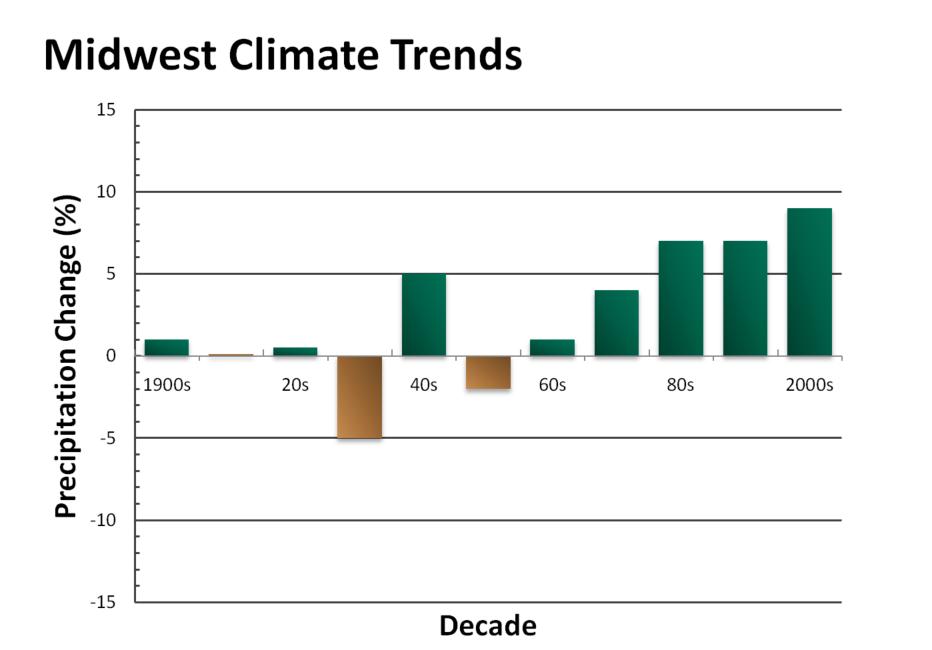
Communities across the St. Louis region typically have stormwater drainage systems and detention or retention basins designed to reduce downstream flooding by temporarily storing runoff and gradually releasing it over time. Basins built after 2008 may also have additional features that improve water quality or protect stream channels from erosion.
Given the increase in the variability and intensity of storm events and flash flooding observed over the last decade, further consideration may be needed by streamside landowners and communities alike to determine how to best manage future climate influences on streams.
Erosion Prevention
the graph is for 2001-2012. (4)
Erosion is a natural stream process. When left to its own devices, a stream is a dynamic thing. It wanders left to right (meandering) and erosive forces shape, and reshape, the channel and floodplain. Soil scours out here and deposits there in a healthy balance.
But when climate influences or development and urbanization put stress on natural stream systems, erosion can accelerate beyond the norm. This leads to decreased bank stability and a diminished capacity to handle flood waters. Excess sediment clouds the stream and fills in critical habitat in the streambed. In other words, excess erosion can cause property damage and degrade water quality and habitat.

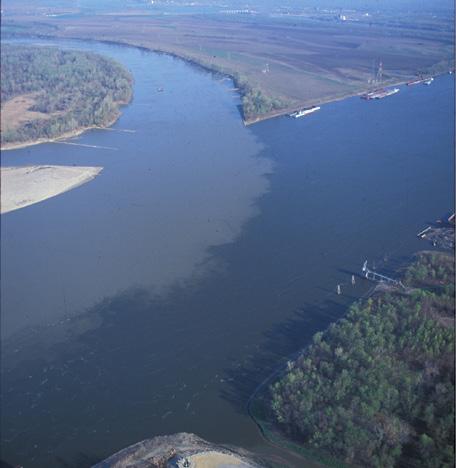
Raindrops fall at a speed of about 30 feet per second, or 20 miles an hour. They can splash mud as much as two feet high and five feet away.
Meander bends are a natural way streams slow the movement of water and dissipate energy.(5)

One of your best defenses against eroding streambanks is to maintain and protect the riparian zone along streams. Here are some additional erosion control strategies:
• Enhance the buffer with more native trees, shrubs and ground-story plants.
• Avoid shallow-rooted vegetation such as turf grass.
• During construction, protect bare and disturbed soils. Use erosion control and replant as quickly as possible.
• Assess activities that can degrade vegetation, such as trampling by equipment, animals and people.
• Homesite and landscape planning should always respect the riparian zone and the floodplain. Don’t encroach!
Average precipitation differences by decade from 19012012 (relative to the 1901-1960 average). The far right bar in
Missouri and Mississippi River Confluence (view northwest, upstream)
www.hudsonestruaryresiliency.net 32 | St. Charles County Stream Care Guide
© 2000 Airphoto, Jim Wark
Stabilization Techniques
A healthy buffer of plants in the riparian zone may not always be enough to prevent damage to streambanks. In some cases there simply is not enough land to work with. Perhaps the bank instability is too severe, or stream conditions too challenging. In these instances more engineered restoration techniques may be needed—both on the banks and in the stream. Any work within a stream must be based on information not only about the stream, but also about the surrounding watershed.
This guide highlights a few stream stabilization techniques and resources commonly used in suburban/urban areas. Keep in mind that incorrect installations can aggravate problems or cause new problems for other property owners. Consult with a qualified professional in bank stabilization and stream restoration if you have a serious erosion problem or issue that may affect a structure. See Plan Approval and Permits on page 38.
Traditional Approaches
failure.
Channelization (i.e. making it straighter and/or wider) or armoring with concrete, walls or gabion baskets along banks have been commonly used. These measures do not allow streams to function as a natural system, and often increase problems downstream. They increase flow velocity due to lower hydraulic roughness compared to vegetated banks.(8) They also degrade rapidly when increased volume and velocity further erode banks at the edges of the hard surfaces, undercutting the hard structures, causing them to break apart and fail. Erosion is often observed as well, from downcutting (also called incision), headcutting (eroding upstream) and meandering as the stream attempts to regain balance.
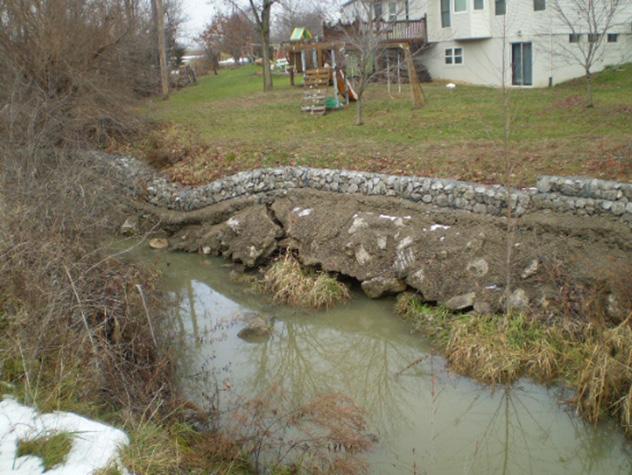
Natural Channel Designs
Natural channel designs use the principles of fluvial geomorphology (the river science that studies processes by which moving water shapes land) to evaluate the potential for a degraded stream to be restored to its historic stable form. It focuses on achieving a balance between the driving and resisting forces that cause changes to a channel’s shape. The end result is a self-sustaining stream system that provides valuable hydraulic (water transport), geomorphic (sediment erosion and transport) and ecological (habitat, water quality) functions. Natural channel design techniques vary, depending on if there is space adjacent to the channel to allow for increased water on the floodplain without damaging nearby infrastructure.
When driving forces exceed resisting forces, the stress applied by water or sediment exceeds channel strength (applied shear). The channel subsequently responds by altering its 3D geometry to accommodate the changes in flow volume and applied shear. Once disturbed, the processes by which streams may respond are: (6)
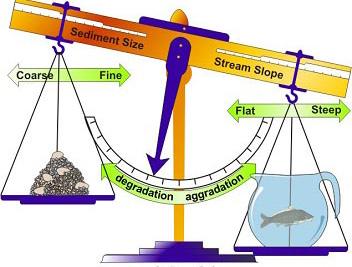
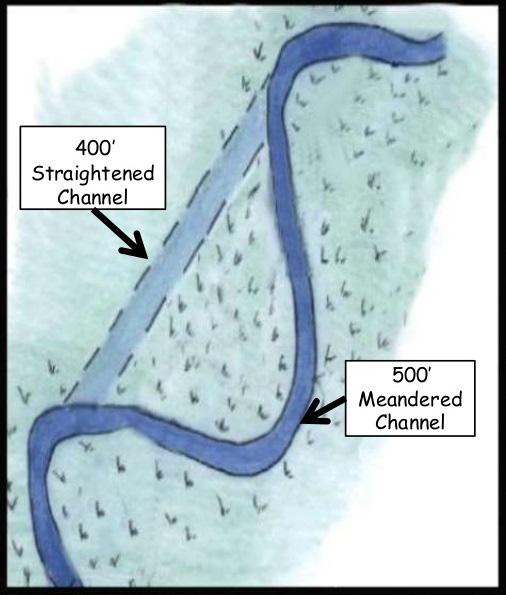
a. Incision (vertical degradation)
b. Widening (horizontal)
c. Deposition or Aggradation
d. Meandering
Effects of Channelization (5,6)
1. Shorter channel length means a steeper slope.
2. A steeper slope increases velocity.
3. Increased velocity increases erosion on the streambank and in the channel bed.
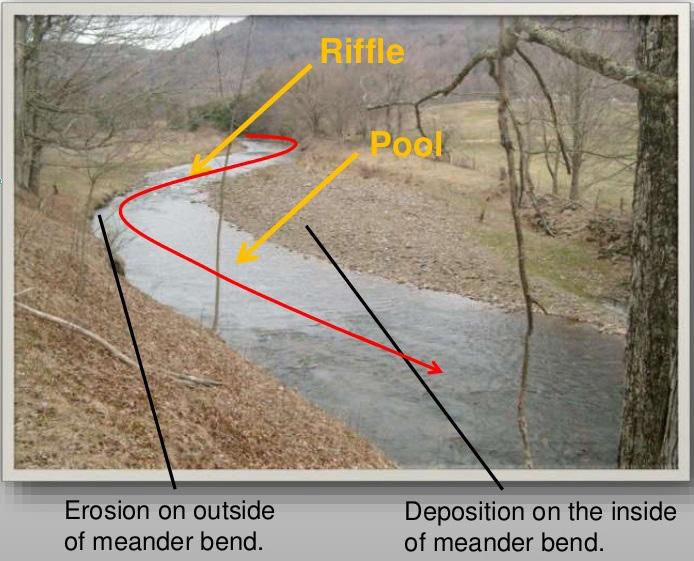
4. Increased velocity means flashier flooding.
Lane’s Equation (7, 8)
Streams are said to be in dynamic equilibrium when the volume of water is enough to transport the available sediment without building up the channel (deposition) or cutting down the channel (incision).
www.hudsonestruaryresiliency.net St. Charles County Stream Care Guide | 33
Hard armoring with concrete and gabion baskets on this bank is undercutting, causing more global
Streams go through six stages of channel evolution (diagram below) to eventually re-establish equilibrium. Determining which process (incision, widening, deposition or meandering) is dominant, and the likely progression of that process, is one of the primary challenges of stream management.(6)

Statistically, a healthy stream system has a 66% chance of overflowing its bankfull channel in any given year, or every 1.5 years on average. This process promotes many valuable stream functions, including flushing pollutants and organic matter out of the stream and filtering them into the floodplain. In a degraded system, the channel often erodes down (incises) so deeply that the stream is no longer connected to its floodplain, except during the most extreme flood events. This limits beneficial stream functions and exacerbates bank erosion problems.

Grade control structures and step-pool systems (shown below) are types of natural channel design that controls incision by stabilizing the streambed’s slope. This is similar to terracing hillslopes on a farm field to control erosion. Other flow control structures, such as dikes, vanes, drop structures, longitudinal stone toe protection, stream barbs and bendway weirs are designed to reduce forces against the bank by controlling the direction, velocity or flow depth.
 Simon, A., Hupp, C.R., 1986, Vol. 2
Simon, A., Hupp, C.R., 1986, Vol. 2
34 | St. Charles County Stream Care Guide
Stream Channel Evolution Model
Streambank Bioengineering
Streambank bioengineering is a restoration method dating back to the 12th century in China where brush bundles were used to stabilize slopes. It integrates living plants in bank stabilization, as opposed to only using inert materials (such as logs, rocks, etc). With their flexible stems and dense, deep root systems, native willows and dogwoods that grow right at the water’s edge are invaluable to help stabilize streambanks. Roots hold the soil together while above ground vegetation protects against flood damage by dissipating energy and acting as a buffer against the abrasive effects of sand, silt and rocks carried in the stream. These riparian shrubs thrive on the periodic “pruning” caused by seasonal high flows and wildlife browsing and will re-sprout vigorously. Branches that are broken off and carried downstream can take root anywhere along the stream. This feature makes willows, dogwoods and cottonwoods an important component of streambank bioengineering projects. Cuttings can be harvested in large quantities and then installed in a variety of bioengineering applications, based on site-specific needs. See Native Plants for Riparian Zones on page 30 for selecting plants.
In relatively stable streams, slopes that are biostabilized with erosion control blankets and plantings can be constructed at a 3H:1V slope, or flatter, to further protect the bank by reducing the bank slope and planting vegetation to hold soil in place. This may not be effective if there are buildings or other improvements at the top of the slope.
Rock is used in conjunction with plants to stabilize banks where velocities are high, long term durability is needed, immediate stabilization is needed or there is significant threat to life or property. Rock is often used to protect the toe of the bank (where the streambed meets the streambank), which is the area of highest stress in the stream channel. Instream rock grade or flow control structures may also be used to deflect flow away from eroding streambanks, concentrate flow in the center of the channel, create pool habitat for fish, and encourage sediment deposition and scour.
Cuttings from dormant riparian shrubs are planted deep enough in streambank soils to reach the dry season water table. These "live stakes" are used in a variety of bioengineering techniques. Stem nodes will take root. Nodes above the ground will leaf out.

Other bioengineering practices such as composite revetment or rock armoring bank slopes with livestakes are becoming more common. Both techniques may include using (unvegetated) loose rock toe protection that can self-adjust by launching into any future scour area, or larger rock trenched into the ground parallel to flow and deeper than any anticipated future scouring in the channel bed.
Composite revetment protects the bank by placing rows of rock armoring along the slope and planting rows of one- to two-year-old rooted vegetation between each row of rock. Composite revetment is typically used in areas with high shear stress or where the banks are fairly tall (generally up to a 2H:1V slope) because the plants can be separated (stratified) from waterloving plants near the bottom of the slope to drought-tolerant plants near the top (see panel of photos at right).
Rock-lined slopes planted with livestakes protect the bank by placing a layer of rock armor on the slope and planting live cuttings of woody vegetation (livestake) through the rock layer. Livestakes are typically installed in winter when dormant, by driving it between gaps in the rock, and down into the soil below. This technique is typically used on shorter banks where plant stratification is not needed. Species of woody vegetation that will root from a live cutting are generally limited to riparian trees and shrubs that thrive in areas of high moisture, such as willows, cottonwood and some dogwoods.
Composite revetment on the left bank and rock-lined slope with livestakes on the right bank along a stream in Wentzville is shown:

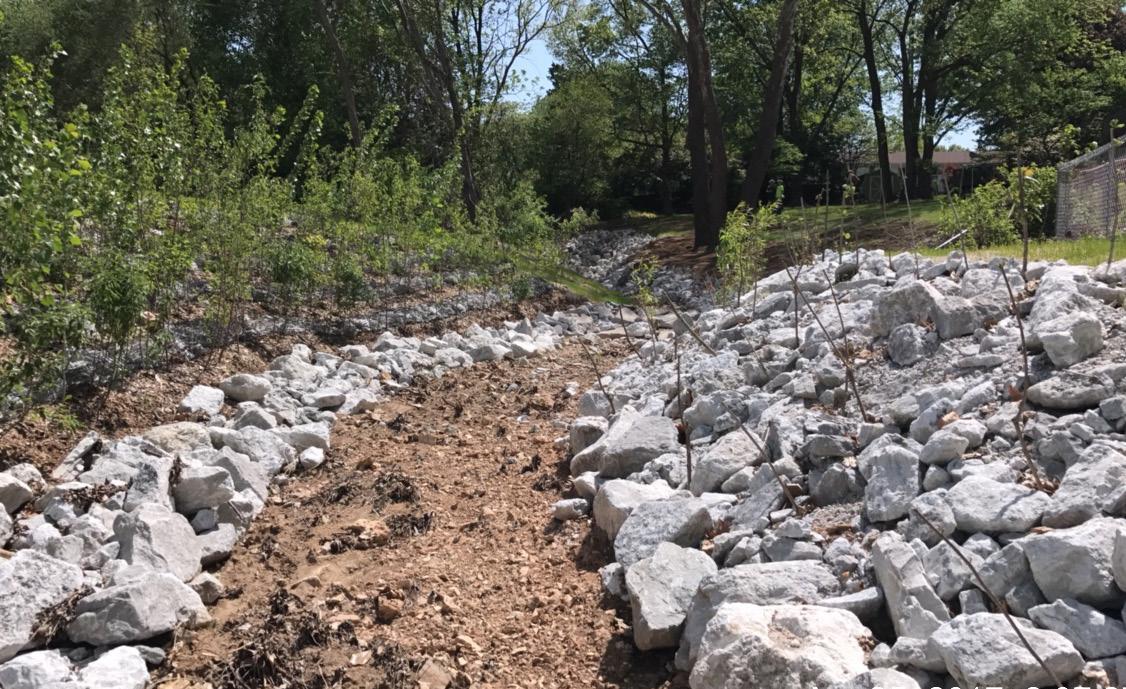
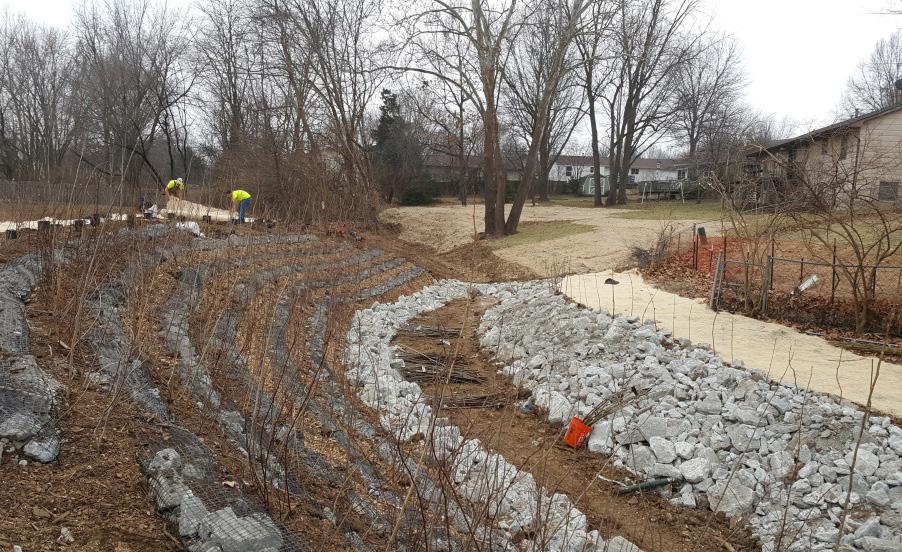
• During construction (top)
• Two months after construction (center)
• Three months after construction (bottom)
Jamie Paige
Jamie Paige
St. Charles County Stream Care Guide | 35
Jamie Paige
When Should You Call an Expert?
The following section provides general guidance to assess stream impacts and restoration methods. This does not replace consultation with a qualified professional to fully evaluate the dominant processes occurring on your property and beyond its boundaries. Bioengineering projects may rely on a team of civil engineers, stream geomorphologists, soil scientists, horticulturists and construction contractors. Keep in mind that dumping leaves, grass clippings or slabs of concrete over the bank usually causes more erosion, rather than resolving a problem. You may be liable for changes made to your property, and for incorrect design or construction that can aggravate or cause new problems for adjacent property. See Plan Approval and Permits on page 38, and Engineers, Contractors and Suppliers on page 40.
Is There Minor, Moderate or Severe Instability?
Considerations
It helps to get to know your stream thoroughly in all seasons of the year. Review the following when evaluating if minor, moderate or severe stream instability exists:
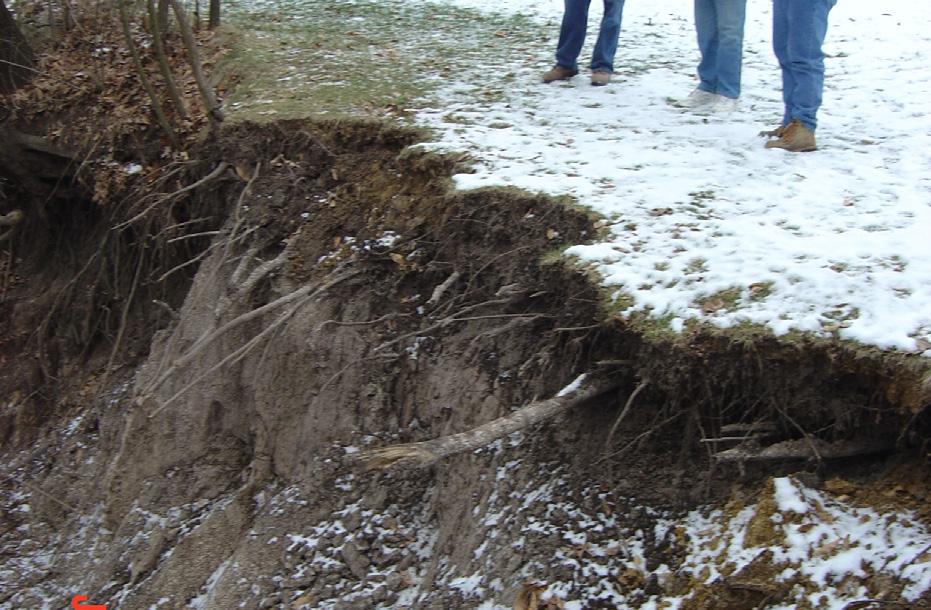
• Extent of instability (the entire stream reach, or segment, in relation to what is within your property boundaries)
• Proximity to improvements (homes, sheds, fences or other infrastructure)
• Changes to width or depth — Have there been significant changes to the streambed (incision) or excessive meandering over a relatively short time?
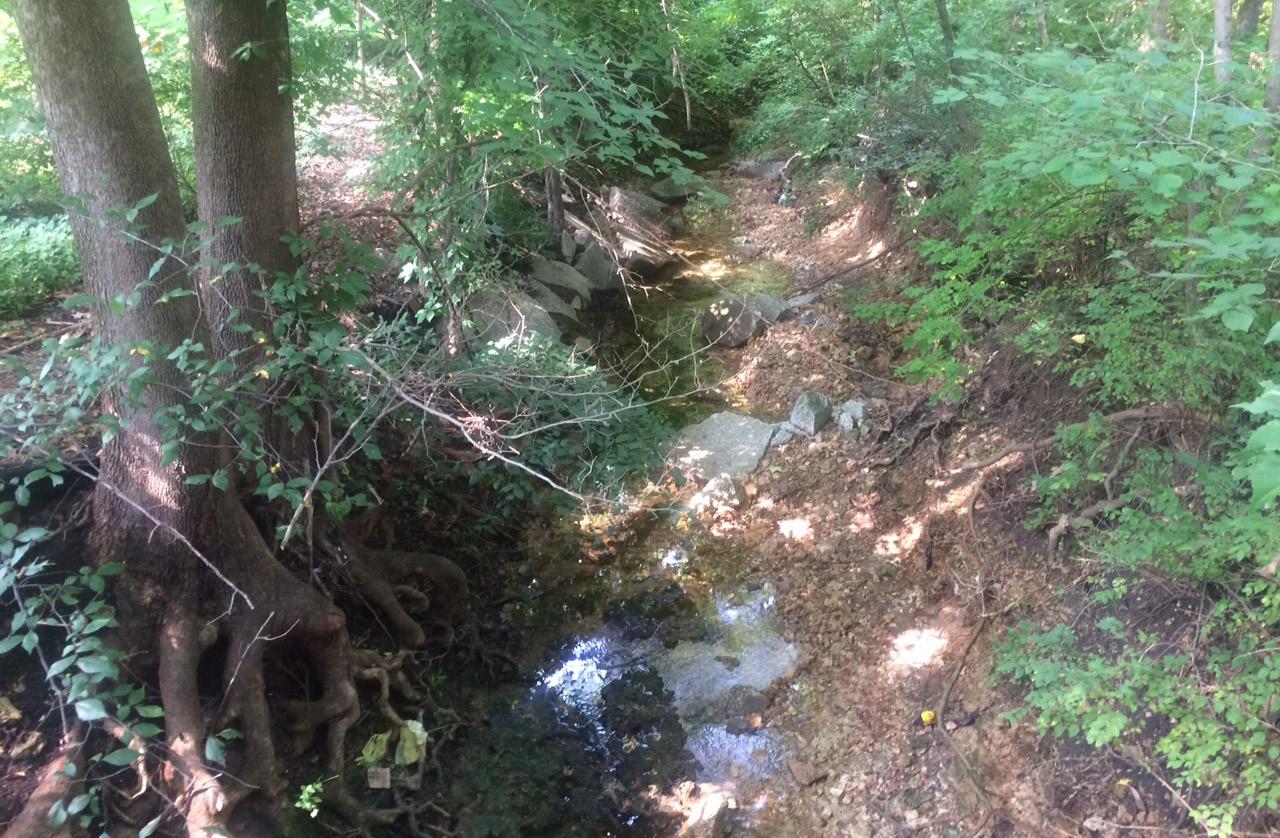
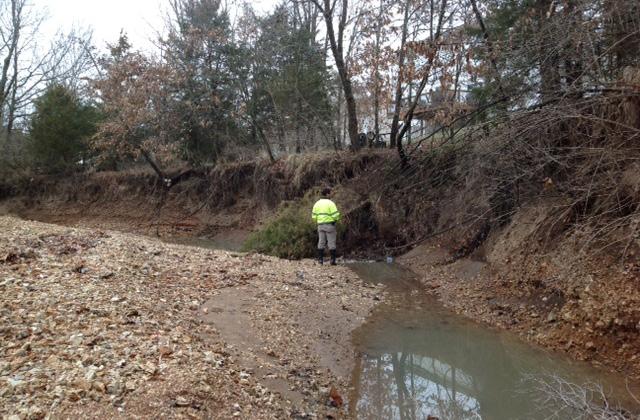
• Riparian corridor health and types of vegetation
Observations
Minor Stream Instability: Upstream and downstream appear stable. There are no significant changes in the stream reach over time (width, depth and reach length). Exposed fibrous roots from undercut vegetation is dark or "barked" over. The top of bank appears to be at or near the normal high water elevation. You may see excessive sediment deposit or erosion at this stage. Excessive deposition can be thought of as a stream trying to spread out; sand bars may form, and stream flows may blaze new paths. This may signify changes to stream equilibrium upstream. Excessive erosion may signify changes to stream equilibrium downstream.
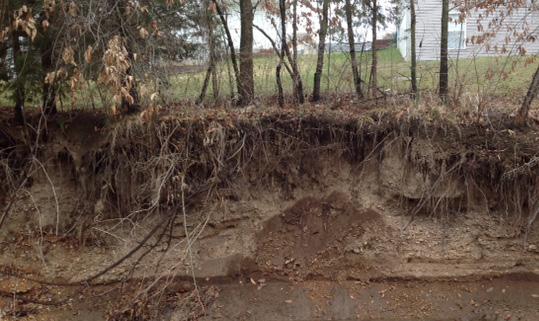
Moderate Stream Instability: Upstream and downstream have minor or unrelated impacts. There are some changes over time. Bare soil (scour) and exposed, fresh fibrous roots (white or orange-colored) may be evident along the bank. There may appear to be a discrepancy in the top of bank elevation to the high water level. This indicates the stream is incising, or downcutting. Failure to restore stability at this point can eventually result in bank widening and subsequent property impacts.
Severe Stream Instability: Upstream and downstream do not appear stable (incising or excessive meandering). There are significant changes in the stream reach over time (width, depth and reach length). The banks may appear to be shear drop-offs to the water below. This indicates the stream has incised and is currently widening. Streams are intended to overflow their banks once about every 1.5 years, so when that is no longer possible due to the deepening of the stream, flood-level flows typically erode streambanks even further.
Minor Moderate Severe
Soil & Water Conservation District
Jamie Paige
36 | St. Charles County Stream Care Guide
Jamie Paige
Next Steps
Minor Stream Instability: It is best to ensure the streambank remains stable and connected with the stream, and the stream has some room to overflow. For excessive erosion, steps can be taken to slow the water down by using vegetated approaches. Outside bends should be protected the most. Ensure a healthy and robust riparian buffer zone of native plants, whose deep root systems do wonders to hold soil in place. Work with neighbors to remove any significant artificial or natural blockages along the stream only if they pose serious flooding or erosion hazard by deflecting flow toward unpredictable courses that could lead to erosion. Oftentimes, fallen trees actually help deflect waters away from compromised banks and slow down water velocity. Avoid removing branches, boulders and dead vegetation where possible as it provides food and cover for fish and wildlife.
Moderate Stream Instability: At this stage, it is important to reconnect the bank with the stream. There should be a gentle slope from your property down to the water (in most cases). If not, some earthwork may be required to restore the slope. Steps should be taken to protect the bottom of the slope (also called the toe), as the stream may begin to scour on the outside bends. Rock-armored slopes can be useful, as well as in-stream grade controls. Seeking advice from a professional is recommended at this stage, especially when you suspect incision (i.e., grade controls are essential), that can impact both up and downstream. After the slope is restored, livestakes are a good idea to naturally re-stabilize the bank for an effective long-term solution. See Streambank Bioengineering on page 35.

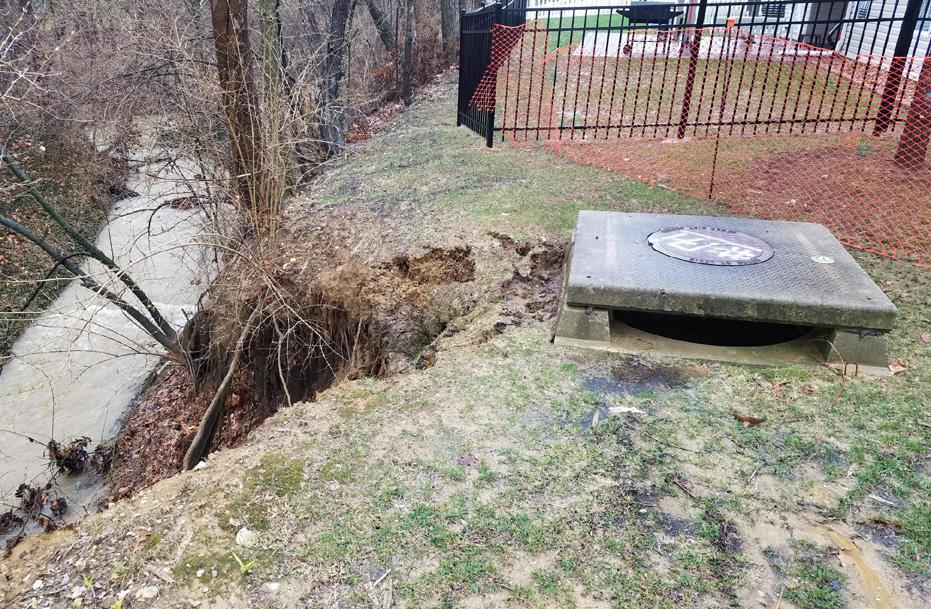
Severe Stream Instability: Professional engineers should be sought to assess your stream reach, as well as both up and downstream. Often, the root causes are far away from your property, and addressing issues on your property alone may only be temporary or a poor use of your money. Consult with a professional to determine the best course of action and options. See Engineers, Contractors and Suppliers on page 40.
Lessons Learned from a Thousand Streams
According to a streambank specialist at Midwest Streams Inc., “Streams are dynamic. Stabilizing them is not always as simple as planting vegetation or dropping rocks in a creek.” Through many years of experience from the Natural Resources Conservation Service, the following guidance is based on observations of design and construction projects across the Midwest:
• Work with nature — follow natural patterns with smooth transitions.
• Solutions should allow for stream adjustments — vertical and horizontal; loose stone works best.

• A stable stream channel slope is ALWAYS required.
• A stable toe is essential — do NOT depend on vegetation for toe protection.
• Vegetation is secondary — plants only stabilize banks when the stream is near a state of equilibrium; nature will plant vegetation on a stable slope; do NOT depend on vegetation for incision or excessive meandering.
When designed correctly, natural channel design and bioengineering projects require less maintenance, blend into and become part of the natural landscape over time, and ultimately reduce overall costs. For more on biostabilization techniques, refer to the USDA NRCS National Engineering Handbook “Stream Corridor Restoration: Principles, Processes and Practices” available at www.usda.gov.
Minor
Moderate
Severe
Jamie Paige
Jamie Paige
St. Charles County Stream Care Guide | 37
Jamie Paige
For More Information
Plan Approval and Permits
Project Planning Assistance
Technical assistance is available for informal guidance to ensure riparian and streambank projects are designed properly. Plan review may be required in some situations, such as altering banks, storm drainage channels or site drainage. Refer to your record plat to identify property boundaries and existing easements. Preliminary conferences are encouraged, as incorrect installations can aggravate existing problems, or cause new problems downstream.
Grading/Land Disturbance Permit
Check with your jurisdiction when clearing, grading or removing vegetation in or along streams. If you live in the City of Wentzville, a grading permit is required for grading 20,000 sq. ft. or more. If you live in unincorporated areas of St. Charles County, a permit is required for 5,000 sq. ft. or more. A state land disturbance permit from the Missouri Department of Natural Resources is required for grading one acre or more.
Floodplain Development Permit
Permits and plan review by your local jurisdiction are required for projects that encroach in or fill in regulated floodplains.
Natural Watercourse Protection Buffers
Work that alters a stream’s riparian buffer may be regulated under Wentzville Municipal Code Chapter 725. Generally, streams have a 25-, 50-, or 100-foot setback requirement from the top of each bank, as designated on the Natural Watercourse and Riparian Buffer Protection Map. St. Charles County codes can be found in Section 405 Article VI, Regulations for the Protection of Natural Watercourses and permit requirements can be found on the County’s Watercourse Protection webpage.
State and Federal 401/404 Permits
Before You Start
Local, state and federal agencies regulate work in and around streams. Protect your investment and reduce potential liability by checking for guidance and permits before beginning any stream enhancement, bank stabilization, landscaping or building projects.
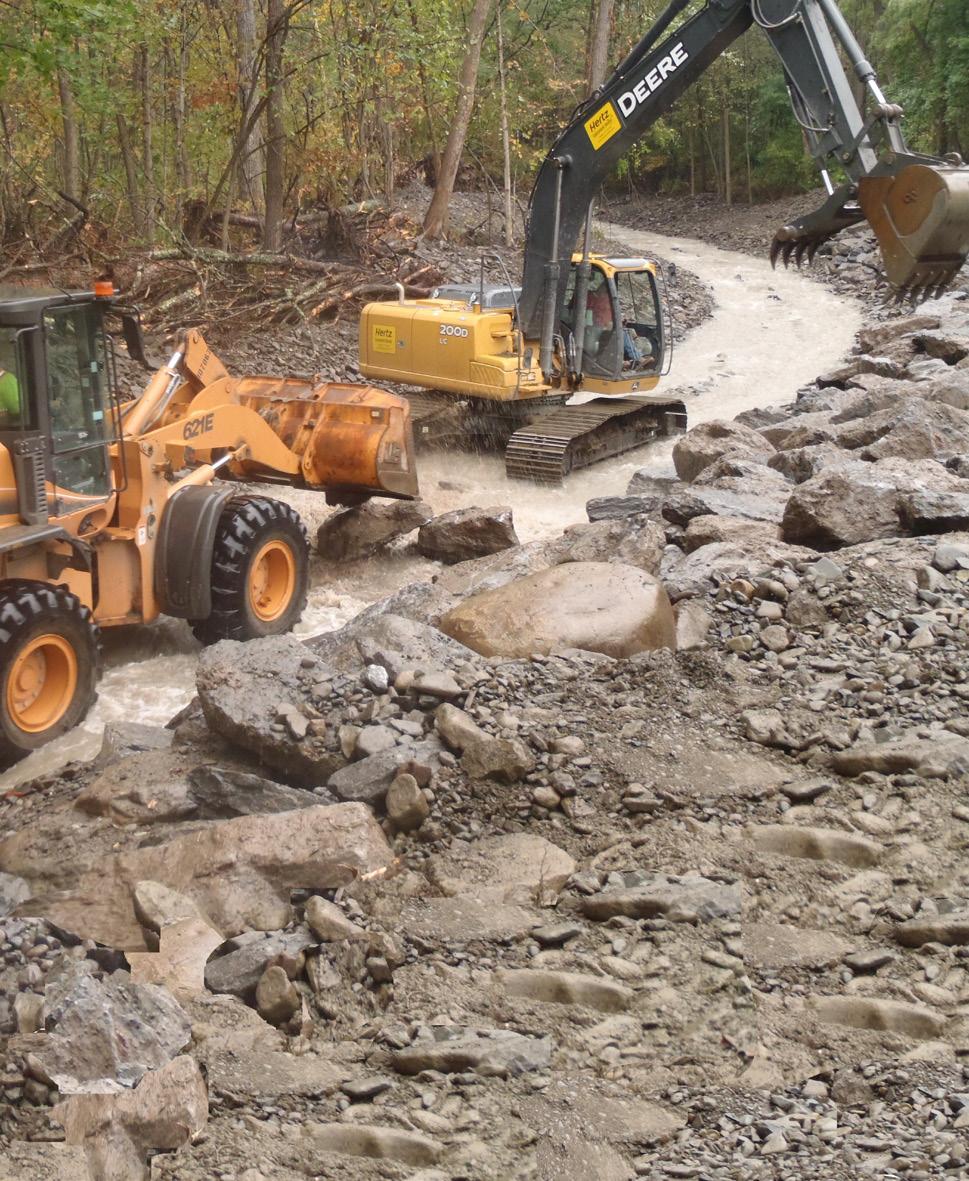
Regulatory Agencies
St. Charles County | Development Review (636) 949-1814
www.sccmo.org/CommunityDevelopment
Missouri Department of Natural Resources St. Louis Regional Branch (314) 415-2960
www.dnr.mo.gov
U.S. Army Corps of Engineering
St. Louis District Regulatory Branch (314) 331-8581
www.mvs.usace.army.mil
Mitigation Areas
Some streams and common grounds are federal mitigation areas. Mitigation areas are created during development to offset impacts to jurisdictional waterways and wetlands. They are regulated by the U.S. Army Corps of Engineers to preserve undisturbed stream corridors and wetlands.
Filling, altering or dredging the bed or banks of the nation’s navigable “jurisdictional” waters and wetlands may require Section 404 Permitting from the U.S. Army Corps of Engineers. The Missouri Department of Natural Resources may also require Section 401 Permitting - Water Quality Certification to be reviewed, which occurs concurrently with Section 404 permits.
Dig Rite - 811
Electric, gas, water, sewer, telephone and cable lines are buried everywhere and some are only an inch or two below the ground’s surface. A job as small as planting a tree or installing a mailbox can damage underground facilities. Call 1-800-DIGRITE, 811 or visit www.mo1call.com to place a locate request.
Check your record plat to determine if mitigation areas exist. Maintenance restrictions are outlined in recorded Declarations of Covenants and Restrictions for the property. To obtain these, contact:
St. Charles County Recorder of Deeds Land Records
(636) 949-7505
www.sccmo.org/Recorder
Soil Testing
Soil fertility can be tested through the University of Missouri Extension, St. Charles County office. Periodic testing helps correct nutrient deficiencies, avoid excess fertilizer applications and maintain a healthy lawn. For more information, visit the website at www.extension.missouri.edu/mp555.
Construction in stream, The Fly Line
38 | St. Charles County Stream Care Guide
Cost-Share Programs and Technical Assistance
The following agencies share the mission to protect local water quality by helping property owners implement wise conservation practices. Landowners and communities may be eligible to receive costshare assistance and/or free technical assistance for managing private property.
Missouri Department of Conservation
www.mdc.mo.gov
(636) 300-1945
Natural Resources Conservation Service
www.nrcs.usda.gov
(636) 922-2833, ext. 3
Missouri Department of Natural Resources Water Protection Program
www.dnr.mo.gov
(314) 416-2960
University of Missouri Extension
www.extension.missouri.edu/counties/st-charles
(636) 970-3000
St. Charles County Soil & Water Conservation District
www.mosoilandwater.land/st-charles
(636) 922-2833, ext. 3
Environmental Concerns
If you are involved in, or witness an environmental concern or emergency, contact:
St. Charles County
Building Code Enforcement Division
(spills and illicit discharges)
(636) 949-7345, bce@sccmo.org
Development Review Division
(636) 949-1814, development@sccmo.org
Missouri Department of Natural Resources
St. Louis Regional Office (314) 416-2960
Environmental Emergencies (573) 634-2436, https://dnr.mo.gov/reporting/environmentalconcern
Native Plant Resources
Grow Native / Missouri Prairie Foundation Seed Suppliers List, Nursery List
(888) 843-6739
www.grownative.org
Missouri Botanical Garden
Native Landscaping Manual, Native Plant School (314) 577-9555
www.missouribotanicalgarden.org
University of Missouri Extension Agronomist, Plant/Weed Identification
(636) 970-3000
www.extension.missouri.edu
Missouri Department of Conservation (MDC) Low-cost Tree and Shrub Seedlings
(800) 669-3787
www.mdc.mo.gov/seedlings
Recycling and Waste Disposal
St. Charles County operates two drop-off facilities that collect and process recyclable materials, including items not typically accepted at the curb, at little or no cost to St. Charles County residents. Check websites below for details before your trip.
In addition, the City of Wentzville and the City of O’Fallon offer annual electronic recycling events. Visit each city's website to learn more.
Recycle Works West
2110 East Pitman Ave.
Wentzville, MO 63385
(636) 949-7900, ext. 4267
www.sccmo.org/recycleworks
Recycle Works Central
60 Triad South Dr.
St. Charles, MO 63304
(636) 949-7900, ext. 4271
www.sccmo.org/recycleworks
Yard Waste
Manage yard waste onsite where it is generated. Homeowners can turn this “waste” into valuable resources. For more information on composting opportunities and yard waste collection:
City of O’Fallon Environmental Services
(636) 272-0477
City of St. Charles Yard Waste Services
(636) 255-6142
City of St. Peters Recycle City
(636) 970-1456
City of Wentzville Public Works
(636) 327-5102
Pharmaceuticals
The following locations accept leftover, over-thecounter and prescription medications. Call before your visit for procedures for proper disposal.
City of St. Charles Police Department
(636) 949-3378
1781 Zumbehl Rd.
Lake Saint Louis Police Department
(636) 625-8018
200 Civic Center Dr.
O’Fallon Police Department
(636) 240-3200
1019 Bryan Rd.
St. Charles County Police Department
(636) 949-3000
101 Sheriff Dierker Ct.
Wentzville Police Department
(636) 327-5105
1019 Schroeder Creek Blvd.
Walgreens — select stores
(636) 332-6217
993 Wentzville Pkwy.
St. Charles County Stream Care Guide | 39
Engineers, Contractors and Suppliers - Stream Stabilization
Engineers
EDM, Inc.
(314) 231-5485
Horner & Shifrin, Inc.
(636) 329-9296
HR Green, Inc.
(636) 519-0990
Intuition & Logic, Inc.
(314) 432-2543
Midwest Streams, Inc.
(618) 830-6318
Reitz & Jens, Inc.
(314) 993-4132
SCI Engineering, Inc.
(636) 949-8200
Terra Technologies
(314) 984-0050
Contractors
JTL Landscaping
(314) 831-3954
Landesign (636) 332-4500
Two Alpha Contracting, LLC
(636) 384-1296
Ideal Landscape Group
(314) 892-9500
Suppliers
ASP Enterprises (636) 343-4357
Filtrexx Sustainable Technologies (877) 542-7699
Hanes Geo Components (636) 875-7317
Engineers, Contractors and Suppliers - Native Landscaping
Plant materials should be suitable for USDA Zone 5. These plants are suitable for, and grown in similar Midwest climate conditions, which increases chances for survival.

DJM Ecological Services, Inc. (314) 478-2388
www.djmecological.com
Native Landscape Solutions (314) 544-7918
www.nativelandscape.biz
Stormwater Pro STL (314) 315-5696
www.stormwaterprostl.com
Forrest Keeling Nursery (573) 898-5571
www.fknursery.com
Missouri Wildflowers Nursery (573) 496-3492
www.mowildflowers.net
Natural Communities
(331) 248-1016
www.naturalcommunities.net
Resources and Ways to Get Involved
Statewide
Missouri River Relief
A volunteer-based organization dedicated to connecting people to the Missouri River through river clean-ups, education and activities based on watershed solutions. www.riverrelief.org
Missouri Stream Team
Training, equipment and events for citizens interested in adopting a stream, water quality monitoring and other volunteer projects.
www.mostreamteam.org
NuWay Companies (314) 544-1214
Profile Products (800) 508-8681
Consult with your local jurisdiction for additional resources. A list of approved contractors is available through the County and many municipalities.

Forest ReLeaf (314) 533-5323
www.moreleaf.org
Prairie Moon Nursery (866) 417-8156
www.prairiemoon.com
Pure Air Natives (636) 357-6433
www.pureairnatives.com
Garden Heights Nursery (314) 645-7333
www.gardenheights.com
Hamilton Native Outpost (417) 967-2190
www.hamiltonnativeoutpost.com
Hillermann Nursery & Florist (636) 239-6729
www.hillermann.com
Rolling Ridge Nursery Inc. (314) 962-3311
www.rollingridgenursery.com
Businesses listed here may provide services in St. Charles County. This is not a complete list and does not constitute guarantee of reliability of quality or product. The sponsors of this guide do not endorse any company, and no discrimination is intended by omission.
Mississippi River Cities and Towns Initiative
A common voice for 124 cities and towns to promote economic and environmental security and stability along the river corridor, spanning political and economic interests.
www.mrcti.org
Mississippi River Collaborative Groups working on issues affecting the Mississippi River and its tributaries.
www.msrivercollab.org
Missouri Geological Survey’s Water Resources Center
Everything you want to know about Missouri’s surface and groundwater resources.
www.dnr.mo.gov/about-us/missouri-geologicalsurvey/water-resources-center
Missouri Department of Conservation
Learn about property management and construction practices to minimize impacts to plants and wildlife.
www.mdc.mo.gov/property
Theresa Strunk
40 | St. Charles County Stream Care Guide
Andrea Placquadio, Pexels
Watershed Information Network
Find a registry of watershed partnerships, locate your watershed and discover scientific information such as streamflow data. https://water.usgs.gov/wsc/trilogy.html
Katy Trail State Park
The 225-mi. Katy Trail State Park follows the Missouri River and is part of the Lewis and Clark National Historic Trail. www.mostateparks.com
Regional OneSTL
Get tools and resources from this St. Louis plan for sustainability. www.onestl.org
Greenway Network
A volunteer nonprofit that conserves natural resources and encourages sound watershed management. Events include Race for the Rivers, Mission: Clean Stream and Confluence Trash Bash. www.greenwaynetwork.org
Great Rivers Greenway
Regional parks & trails district, connecting greenways. www.greatriversgreenway.org
Big Muddy Speaker Series - St. Charles Monthly programs on Missouri River ecology, history and biology. www.bigmuddyspeakers.org/stcharles
Master Naturalists, Confluence Chapter
Volunteers learn and support conservation efforts. www.mmnconfluence.org
Master Gardeners
Get native landscaping advice from this novice to expert group who shares a love of gardening. www.stcharlescountymastergardeners.com
Local Stormwater Management Programs
Volunteer or simply share input with your jurisdiction's five year plan to improve and help protect stream water quality.
Project Examples
Friends of LaBarque Creek Watershed
This model for conservation efforts has conserved over 45% of the watershed (3800+ acres).
https://mochf.org/partner/friends-of-labarque-creek/ Meramec River Project
The Nature Conservancy, a public land trust works with over 29 partners, agencies and landowners to protect the Meramec River. www.nature.org/en-us
Deer Creek Watershed Alliance
Facilitates community efforts to protect and improve water quality, with a focus on plant-based solutions and yard rainscaping. www.deercreekalliance.org
Index
Bold pages denote where terms are explained. Bankfull, 5, 34 Best Management Practices (BMPs), 2, 4 Biodiversity, 28
Bioengineering, 35 - 37 Biostabilization, 37 Channelization, 5, 33 Confluence, 4, 11, 13, 19, 32
Drainage Basin, 2
Ephemeral, 5
Floodplain, 5, 8, 9, 13, 32, 33, 34, 38
Geomorphology, 33
Headcut, 33
Headwaters, 10, 12, 14-18
Hypoxia, 3
Impervious surface, 2, 7, 20, 24
Incision, 4, 33, 34, 36, 37 Intermittent, 5
Invasive species, 28 - 29
Livestake, 30, 35, 37
Low Impact Development (LID), 20
Mouth, 2, 3, 10, 12, 14-18
Native plants, 20, 22, 24, 26-32, 35, 37, 39
Nutrient, 3, 5, 7, 8, 21, 23, 25, 38
Perennial stream, 5
Rain garden, 13, 20, 22
Revetment, 35
Riffle, 5-6
Riparian corridor, 8, 9, 36
Riparian zone, 5, 8, 9, 20, 22, 30, 32, 33, 35
Runoff, 2, 3, 5-9, 13-22, 24, 26, 32
Sediment, 3, 6, 24, 32, 33, 35, 36
Streambank, 3, 5-8, 20, 23, 26, 27, 30, 32, 33, 35-38
Streambed, 5, 6, 21, 31, 32, 34-36
Stream channel, 4, 5, 6, 8, 32, 34, 35, 37
Stream reach, 36, 37
Storm drain, 3, 23, 24
Subwatershed, 2, 10-11
Swale, 20, 22, 23
Tributary, 2, 7, 10, 12, 13, 40
Watershed, 1, 2, 4, 5, 10-19, 23, 33, 40
Wetland, 4, 5, 6, 14-20, 27, 31, 38.
References
1 “Impacts of Urbanization on Surface Runoff of the Dardenne Creek Watershed, St. Charles County, Mo.”, Physical Geography, 30:6, 556-573.
2 “2010 Census Gazetteer Files”. United States Census Bureau. August 22, 2012. Archived from the original on October 21, 2013. Retrieved November 20, 2014.
3 Mississippi River Basin Healthy Watersheds 2017 Progress Report. Natural Resources Conservation Service. www.nrcs.usda.gov. Retrieved December 12, 2018.
4 U.S. Global Change Research Program. (2014). National Climate Assessment. Retrieved February 2019, from U.S. Global Change Research Program: www.nca2014.globalchange.gov/report/regions/ midwest#intro-section-2.
5 Cornell University Cooperative Extension. (2014, 12 8). Hudson Estuary Watershed Resiliency Project. Retrieved 2019, from Streams 101: Stream Basics & Planning for Flood Resiliency: www.slideshare.net/ HudsonRiverEstuaryResiliency/streams-101-stream-basics-planning-forflood-resiliency.
6 Meyer, M. (2018). Fluvial Geomorphology Principles. St. Louis: Intuition & Logic, Inc.
7 University of Arizona. (2006). Arizona’s Riparian Areas. Retrieved February 8, 2019, from Arizona Cooperative Extension: www.cals.arizona. edu/extension/riparian/chapt7/p3e.html.
8 Wayne Kinney, M. S. (2017, 4 24). Geomorphic Reclamation, MidContinent Region Natural Stream Design Workshop. Retrieved February 13, 2019, from Office of Surface Mining Reclamation and Enforcement, U.S. Department of the Interior: www.osmre.gov/programs/tdt/ geomorph.shtm.
9 Petty, A. (2016, 7 28). Farmers get a look at streambank fixes. Retrieved February 13, 2019, from Herald&Review: www.herald-review.com/ news/local/govt-and-politics/farmers-get-a-look-at-streambank-fixes/ article_27ff559f-8629-5752-bade-06ab51b2ad4b.html.
10 Kammerer, J.C., Largest Rivers in the United States, US Geological Survey Open-File Report 87-242 rev. 1990. www.epa.gov/sites/production/files/2015-10/documents/mo_ dardenne-2.pdf
11 “The Missouri River Story”. Columbia Environmental Research Center. U.S. Geological Survey. Archived from the original on May 27, 2010. Retrieved April 10, 2010.
12 Poppenga, S.K., and Worstell, B.B., 2008, Elevation-derived watershed basins and characteristics for major rivers of the conterminous United States: U.S. Geological Survey Scientific Investigations Report 2008–5153, 27 p.
13 Watershed map data from MSDIS. www.usgs.gov/centers/eros/ scienceMSDIS and land cover data from NLCD. www.usgs.gov/centers/ eros/science
14 Peruque Creek Watershed Management Action Plan. May 2005 CDM, City of Lake St. Louis.
15 www.mvs.usace.army.mil/Portals/54/docs/regulatory/publicnotices/ Prospectus%20(2-23-15)%20(2).pdf
St. Charles County Stream Care Guide | 41
Acknowledgements
Many thanks to everyone who contributed to and reviewed this Stream Care Guide! It represents the collective expertise of many individuals. We are thankful for the generous assistance from stakeholders representing concerned citizens, state agencies, consulting engineering firms, municipalities, industry representatives, and stream and water quality professionals.
St. Charles County Government, Community Development

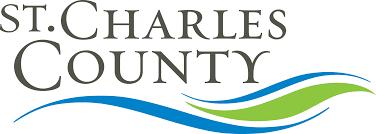
Richard Gnecco, CFM
Paul Mueller
Missouri Department of Conservation

Daniel Moncheski
Matt Matheney
Josh Ward
City of Wentzville
Douglas Lee
Susan Spiegel, P.E.
Doug Forbeck, CFM
Kara Roberson
Sabrina Heffern
Gregory Wallace, P.E., CFM
Devon Dezort, P.E.
Peter Masnica, P.E.
Steve Watson
Disclaimer
Consultants
Wayne Kinney
Mark Meyer, P.E.
Perry Eckhardt
Publication Team
This guide was developed through the St. Charles County Stormwater Collaborative in partnership with:
City of Wentzville
Stormwater Division
St. Charles County Government
Community Development
St. Charles County
Soil and Water Conservation District

Content Development and Organization
Theresa Strunk, Jamie Paige, Kelly Dunlap
This guide is based on the first edition Stream Care Guide: An Owner’s Manual for Streamside Landowners, published by the Soil and Water Conservation District of St. Louis County, and the Stream Care Guide: A Handbook for Residents of Salt Lake County, published by Salt Lake County Watershed.
Every effort has been made to ensure that information contained in this guide is accurate. The Stream Care Guide provides resources for the benefit of the landowners to better understand best engineering design practices and considerations to create sound solutions. This guidance document does not take the place of consultation with an engineering professional. The Publication Team and producers of this guide assume no responsibility and disclaims any liability for any injury or damage resulting from the use of any specified product, technique or information. The St. Charles County SWCD, St. Charles County Government and the City of Wentzville prohibit discrimination in all programs and activities on the basis of race, color, national origin, gender, religion, age, disability, political beliefs, sexual orientation or marital or family status.
Race for The Rivers on the Missouri River, Greenway Network









 O'Day Creek, Theresa Strunk
O'Day Creek, Theresa Strunk


 Little Femme Osage Creek, Perry Eckhardt
Perennial Ephemeral
Little Femme Osage Creek, Perry Eckhardt
Perennial Ephemeral















 Map Image, Kelly Dunlap
Map Image, Kelly Dunlap



 The marshes of the islands and rivers attract duck hunters.
Peruque Creek near Quail Ridge Park.
A view of Dardenne Creek.
Peruque Creek, Perry Eckhardt
Theresa Strunk
Perry Eckhardt
The marshes of the islands and rivers attract duck hunters.
Peruque Creek near Quail Ridge Park.
A view of Dardenne Creek.
Peruque Creek, Perry Eckhardt
Theresa Strunk
Perry Eckhardt



 The Missouri/Mississippi Confluence is one of the area’s best places for bird watching.
Kayakers enjoy the Cuivre River.
A rain garden helps with runoff in a neighborhood above Duckett Creek.
Theresa Strunk
Theresa Strunk Missouri Department of Natural Resources
The Missouri/Mississippi Confluence is one of the area’s best places for bird watching.
Kayakers enjoy the Cuivre River.
A rain garden helps with runoff in a neighborhood above Duckett Creek.
Theresa Strunk
Theresa Strunk Missouri Department of Natural Resources






















































































 Callery Pear Bush Honeysuckle Johnson Grass Sericea Ledpedeza Winter Creeper Reed Canary Grass
Callery Pear Bush Honeysuckle Johnson Grass Sericea Ledpedeza Winter Creeper Reed Canary Grass














 Simon, A., Hupp, C.R., 1986, Vol. 2
Simon, A., Hupp, C.R., 1986, Vol. 2

















